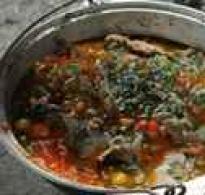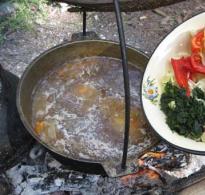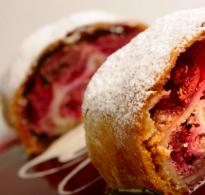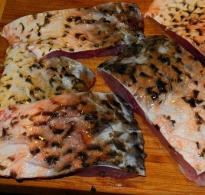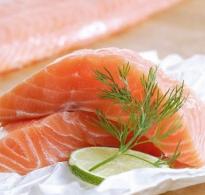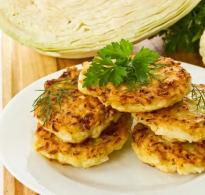Description of false chanterelles, places of distribution. What chanterelles look like: photo, description of mushrooms
False chanterelle - a mushroom that resembles a real chanterelle, but in fact is not related to it. Previously, false chanterelles were attributed to poisonous mushrooms, but now they have been assigned the category of conditionally edible mushrooms.
In many foreign publications, these mushrooms are classified as edible, but it is noted that they have lower taste qualities in comparison with common chanterelles.
The Latin name for the mushroom is Hygrophoropsis aurantiaca.
In everyday life, a false chanterelle is called a kokoshka.
With the right culinary processing poisoning does not threaten these mushrooms, but if there are problems with digestive system a feeling of heaviness is possible, therefore it is not recommended to use them.
Description of false chanterelle
The false chanterelle has a brighter color in comparison with the real chanterelle. Its color is most often orange with a brown tint, the edges are always lighter than the center. The surface of the cap is velvet. Cap color real chanterelle light yellow, sometimes it can be almost white, but can go up to yellow-orange. A real chanterelle can never be as red as its counterpart. In addition, the color is the same both in the central part and at the edges, and the surface is smooth.
The edges of the caps at false chanterelles smooth, neatly rounded. The diameter of the cap does not exceed 3-6 centimeters. In young mushrooms, the shape of the cap is slightly convex, while in mature it becomes funnel-shaped. The edges of the caps of real chanterelles are wavy, their shape is irregular. The diameter of the cap can be up to 12 centimeters. In young true chanterelles, the cap is convex in shape, then becomes flat.
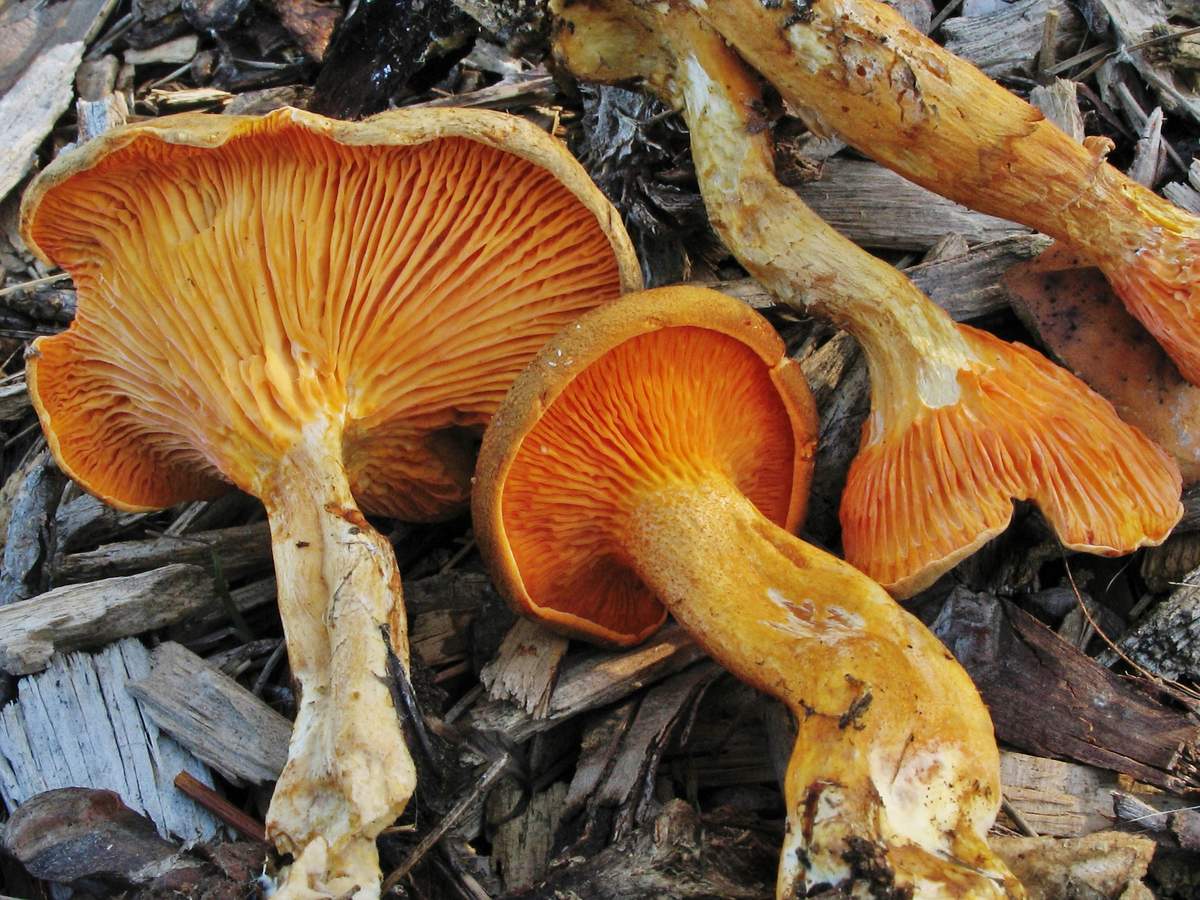
The plates of false chanterelles are thin, often located, not passing to the stem, branching, orange in color. And in real chanterelles, the plates are denser, they go down to the leg.
False chanterelle pulp yellow color, loose, tasteless with not pleasant smell... If you press on the pulp, its color remains the same. In real chanterelles, the flesh is white in the middle, and yellowish at the edges, its taste is sour and has a pleasant aroma.
False chanterelles have thin, red-orange legs. In adult specimens, the legs are hollow. In the lower part, the color of the leg is darker. The shape is cylindrical. The cap is clearly separated from the leg. In real chanterelles, the legs are not hollow, they are thicker, there is no distinction with the cap, dense, smooth, narrowed downwards, of the same color as the cap. In false chanterelles, the color of the spores is white, while in real ones it is yellow.
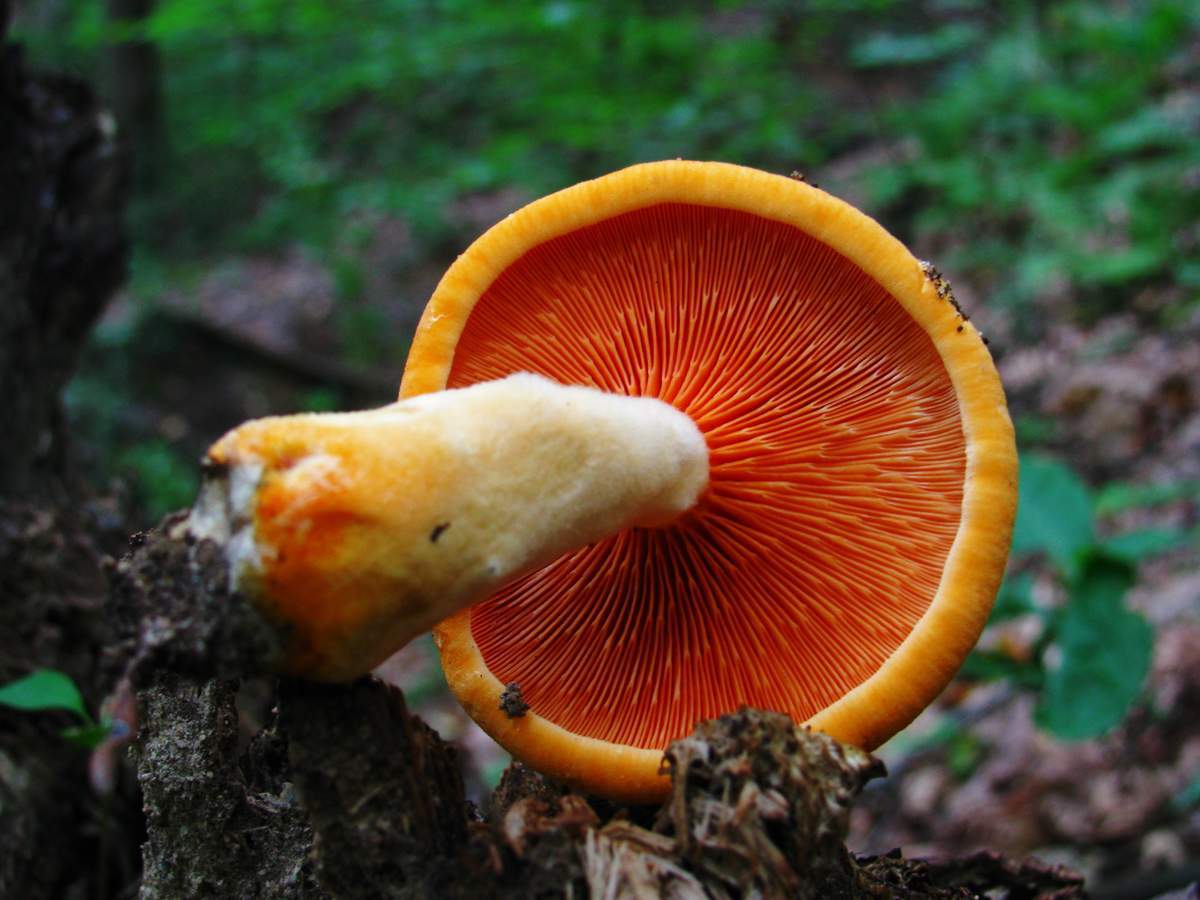
Where do false chanterelles grow?
These mushrooms can be found in mixed and coniferous forests. They are found on decaying wood, in moss, among dead wood. Yields peak from summer to autumn. False chanterelles can grow singly and in groups. Real chanterelles also grow in forests, but they do not inhabit old trees.
False chanterelles often grow in the neighborhood of real chanterelles. Another difference between these similar mushrooms lies in the fact that worms never start in real chanterelles, which is due to the content of chitinmannose in their composition. This substance has an anthelmintic effect. Insect larvae die under the influence of this substance. In false chanterelles, chitinmannosis is not produced, so their fruiting bodies can be affected by worms.
Are False Chanterelles Poisonous or Not?
False chanterelles can be eaten, but they are not particularly tasty mushrooms. Like the rest conditionally edible mushrooms, false chanterelles need preliminary soaking for 3 days. In this case, in the morning and in the evening, the water must be replaced with a new one. After soaking, the mushrooms are boiled for 15 minutes. The false chanterelles can then be marinated or fried.
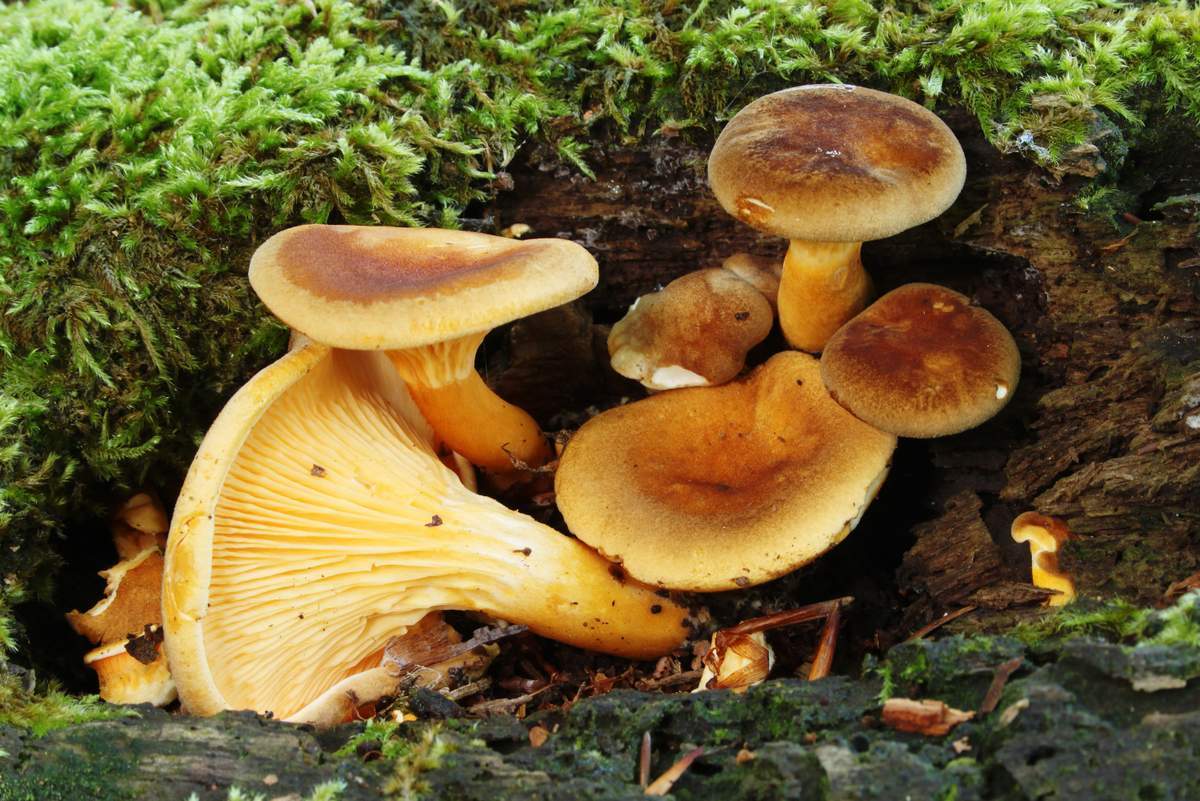
As a rule, experienced mushroom pickers do not pay attention to false faces, since at this time more delicious mushrooms... It should be remembered that in people with a weak digestive system, the use of false chanterelles can provoke a disturbance in the digestive process.
With improper culinary processing of false chanterelles, signs of poisoning appear: nausea, dizziness, vomiting, weakness, upset stools, abdominal pain and cramps. With these symptoms, you should immediately call an ambulance.
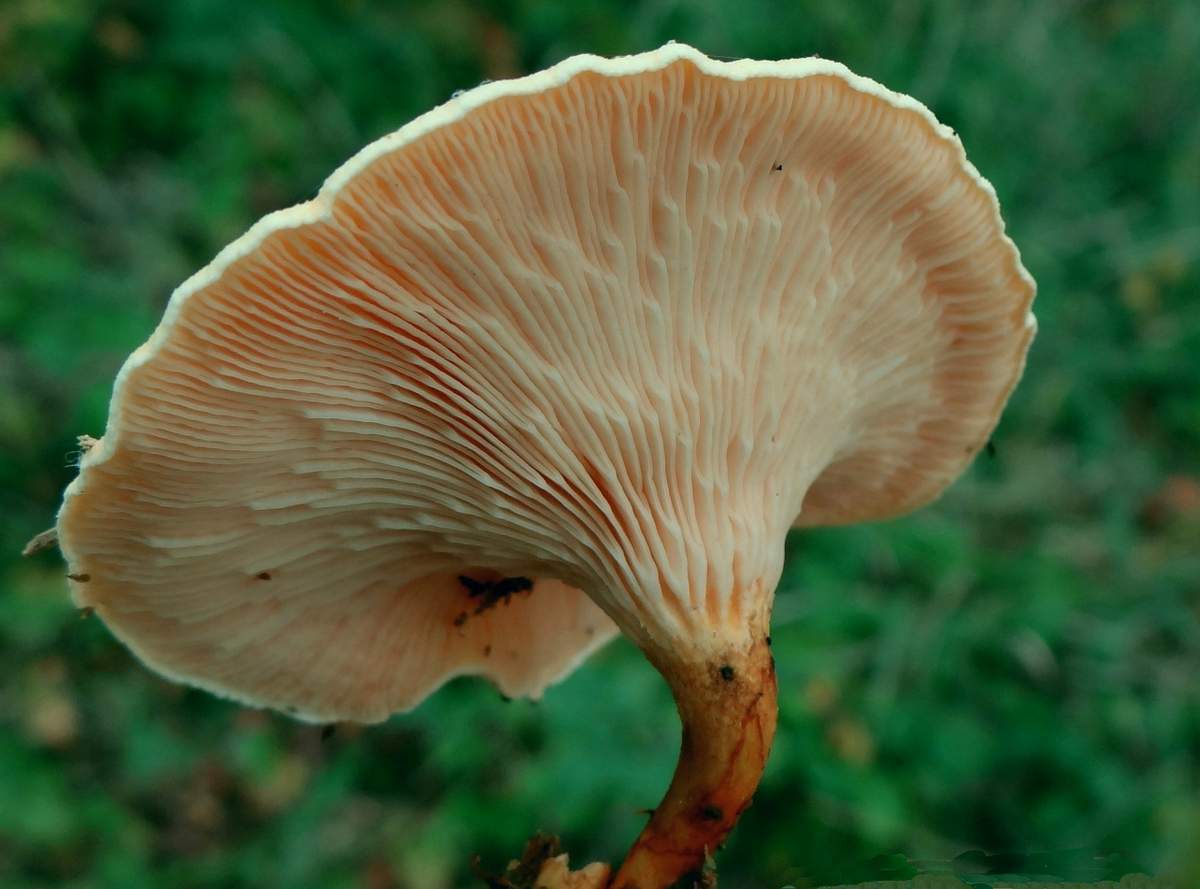
Chanterelles are quite popular and edible mushrooms of the chanterelle family. If you turn to the old Russian reference book, you can find out that "fox" is translated as "yellow". It is thanks to their color and pronounced characteristics that such a forest gift is quite difficult to confuse with others.
Species information and healing properties interesting, it surprises novices and experienced forest dwellers alike.
Chanterelles are quite popular and edible mushrooms of the chanterelle family.
A feature of the body structure of chanterelles, their difference lies in the fact that the upper part and the leg exist as one whole. Uniform formation, without the usual top-mounted cap and detachable stem... Their color is about the same: from light sunny to red (orange).
- The diameter of the upper part is about 5-10 cm, the shape of the cap is flat, the edges are curved, wavy. Mushroom pickers are compared to "the shape of an umbrella turned inside out." If you touch it, then it is smooth, and the skin is difficult to separate from the pulp.
- The color of the edible part of the chanterelle is yellowish, and sometimes white. The flesh tastes slightly sour. Some people feel a mild taste of dried fruit. If you press lightly, the surface will take on a reddish tint.
- The leg is usually the same color as the cap, sometimes a little lighter. By the structure of fibers and spores, smooth and dense. The long one reaches 5-7 cm, and the thickness is 1-2 cm. The base is uniform and slightly narrowed downwards in shape.
Chanterelles usually grow in fairly large groups. They appear well among the grasses immediately after heavy rain. They grow among conifers and mixed trees, near spruce or pine trees.
Useful properties of chanterelles (video)
Places and times of collecting chanterelles
The time for collecting red finds begins from the beginning of the first summer month - June and lasts until mid-autumn (October). The places where they are most often found are characterized by damp terrain, the presence of moss or a large heap of fallen leaves. In addition, they are often found in areas with a temperate climate.
Gallery: chanterelle mushrooms (25 photos)
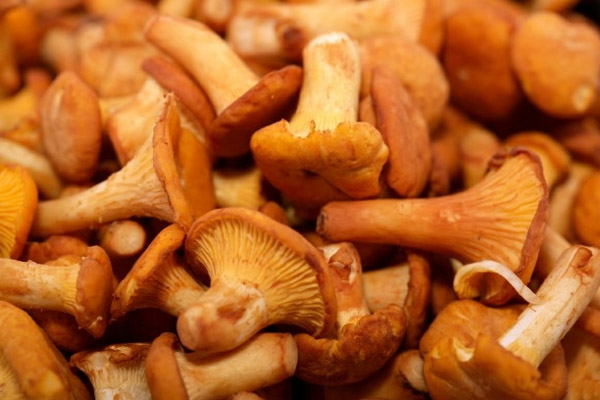

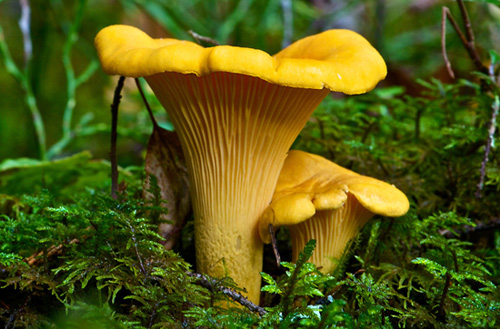
![]()
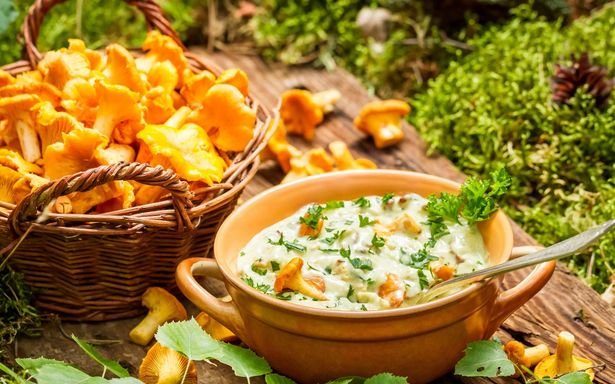
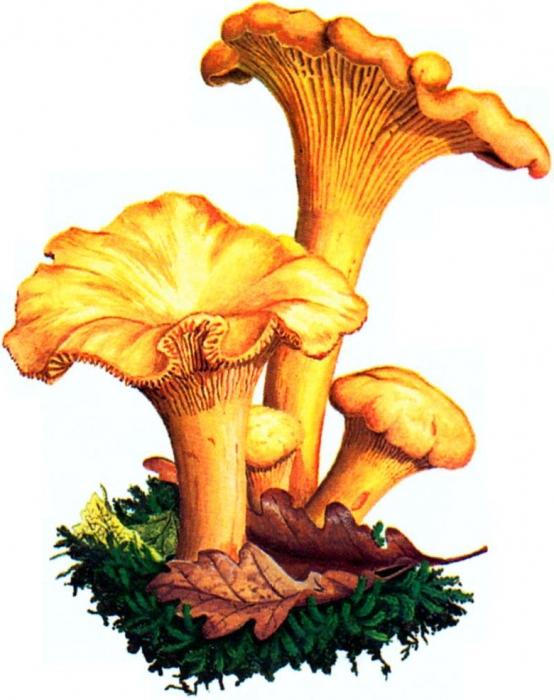
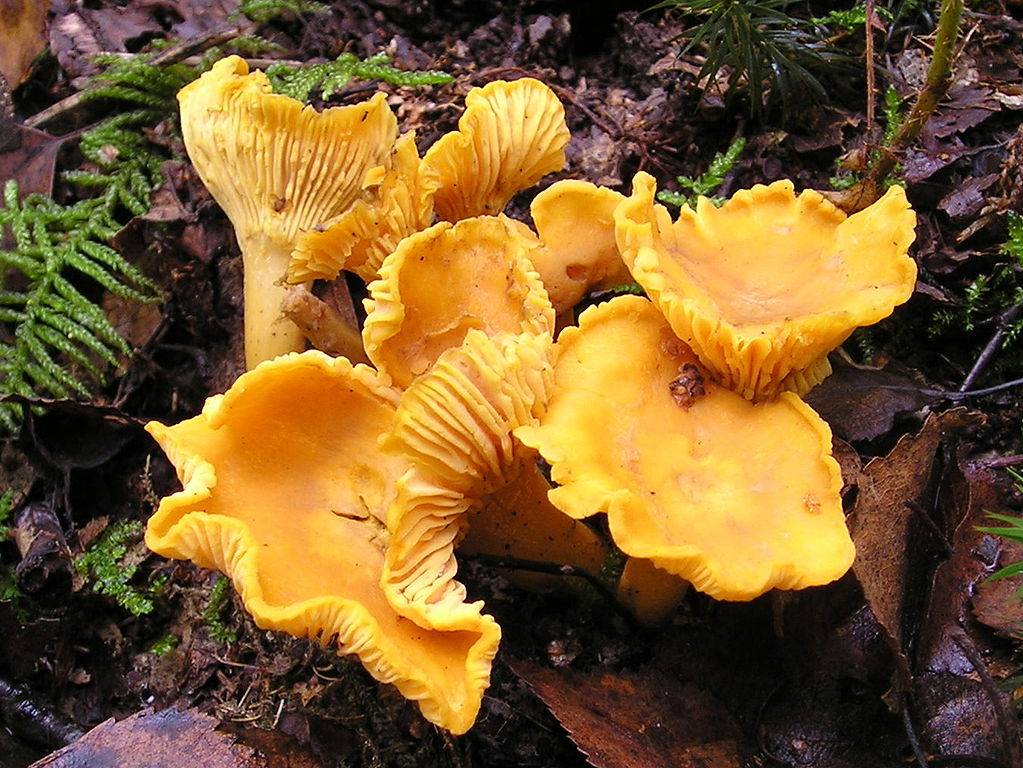
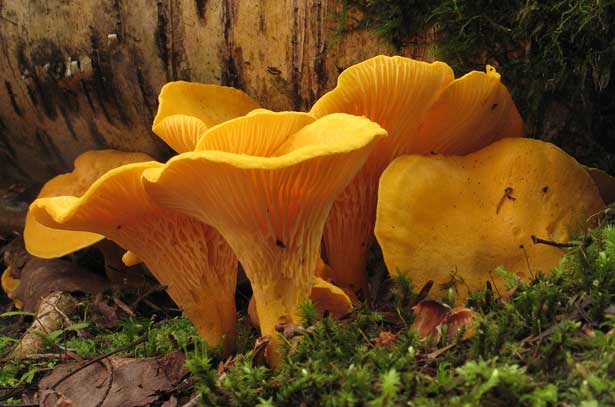
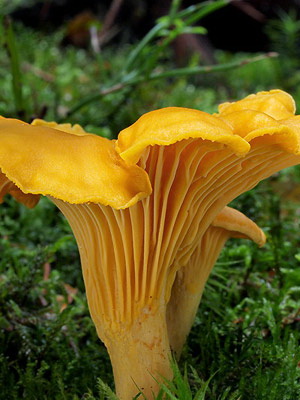
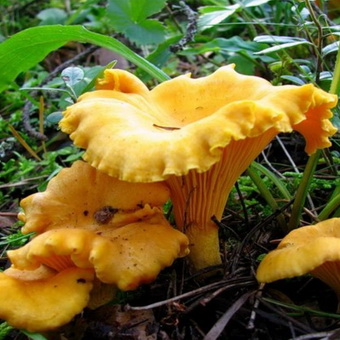
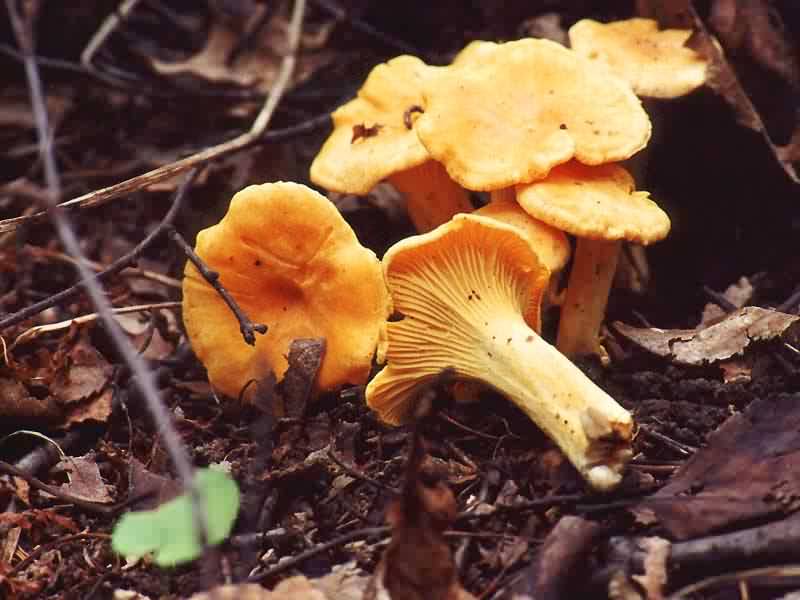
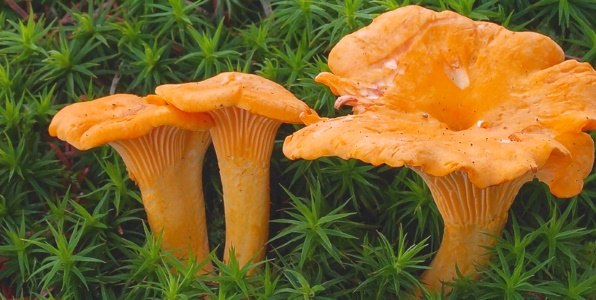
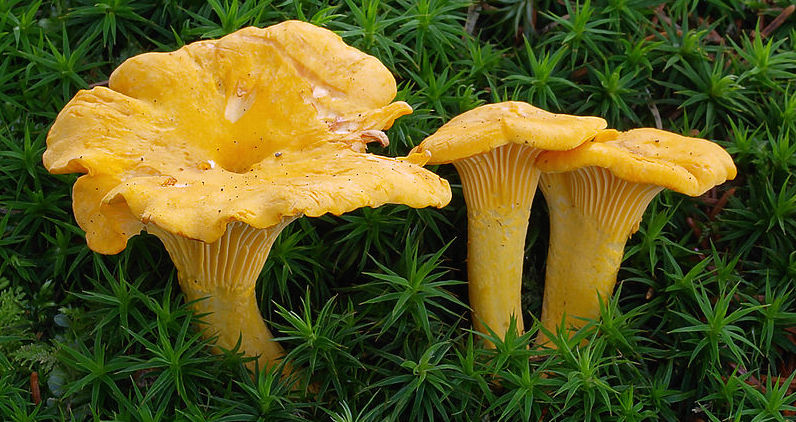
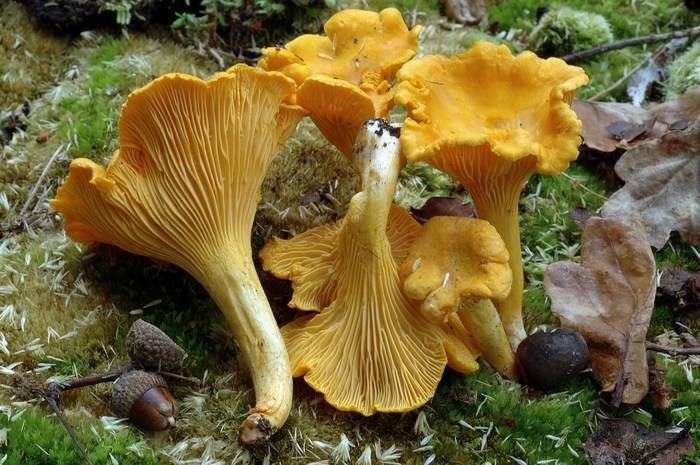
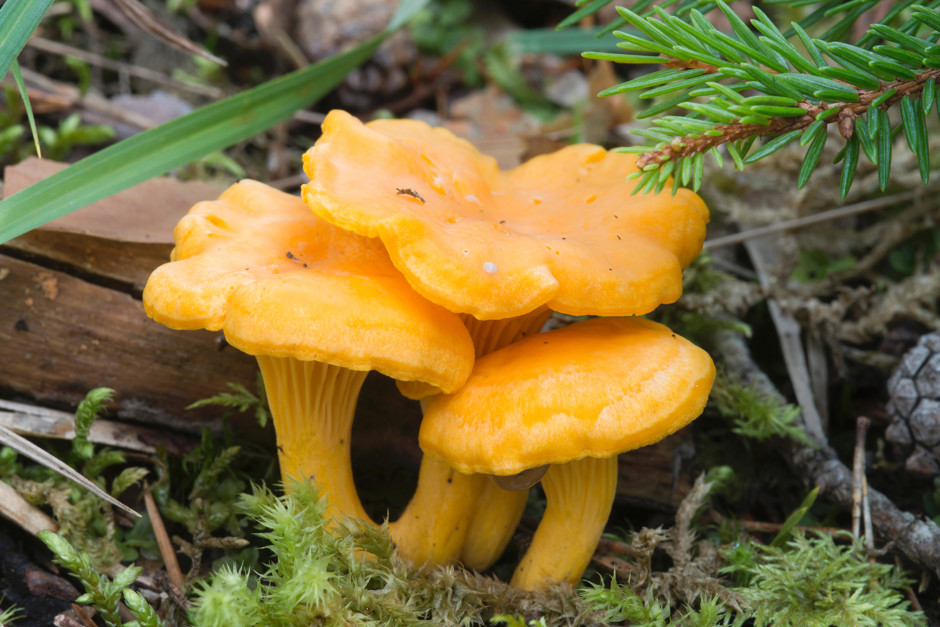
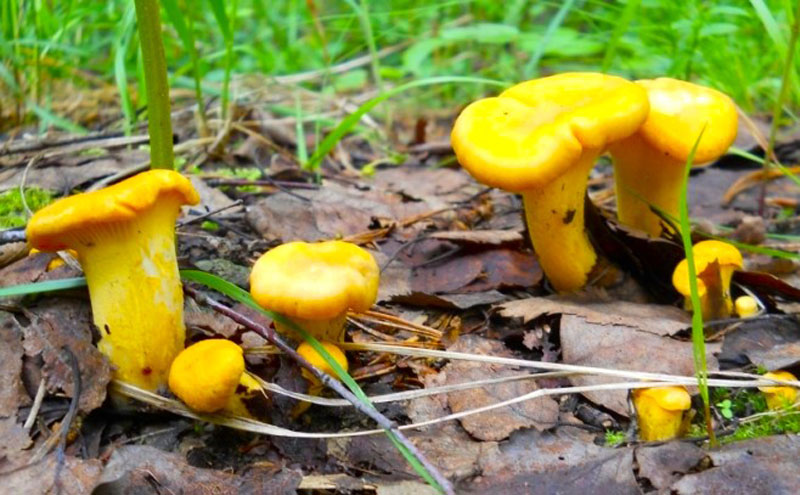
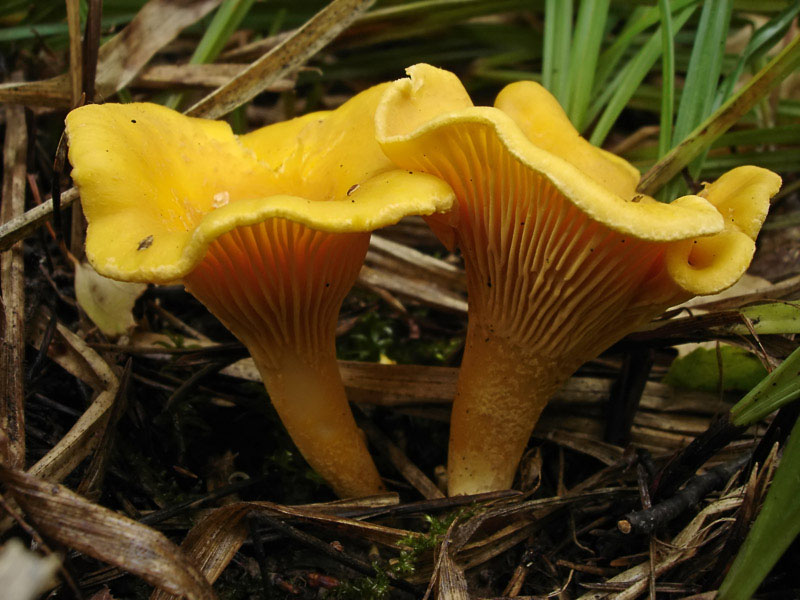
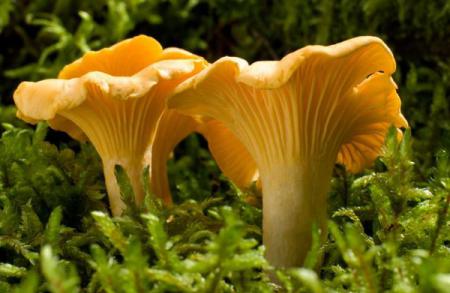
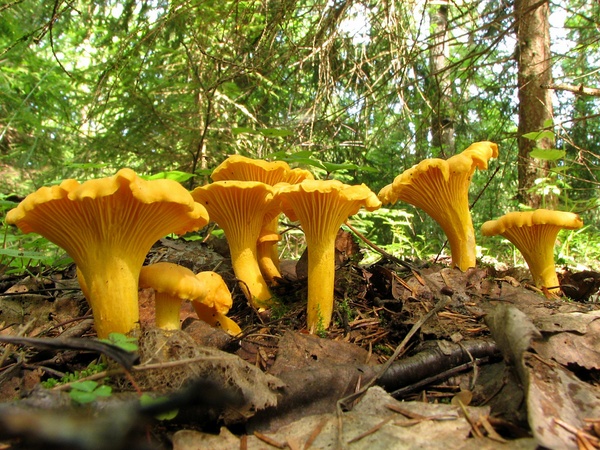
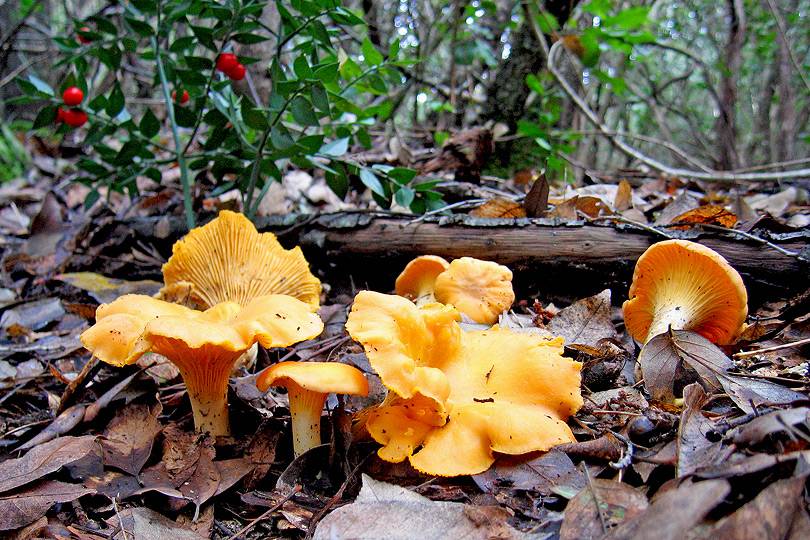
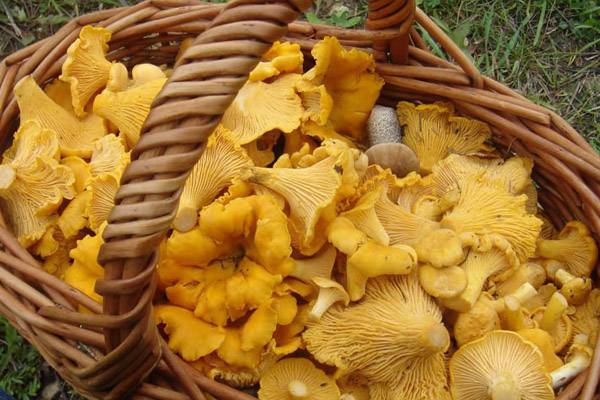
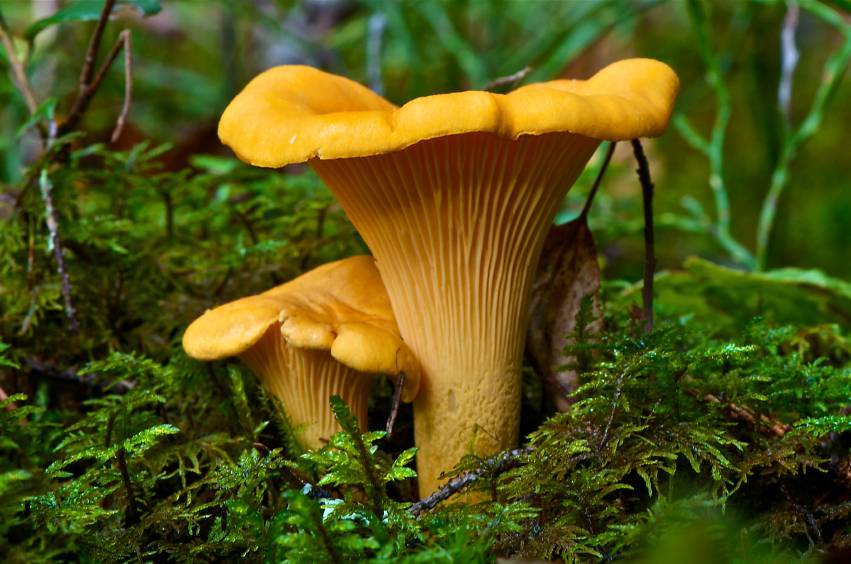
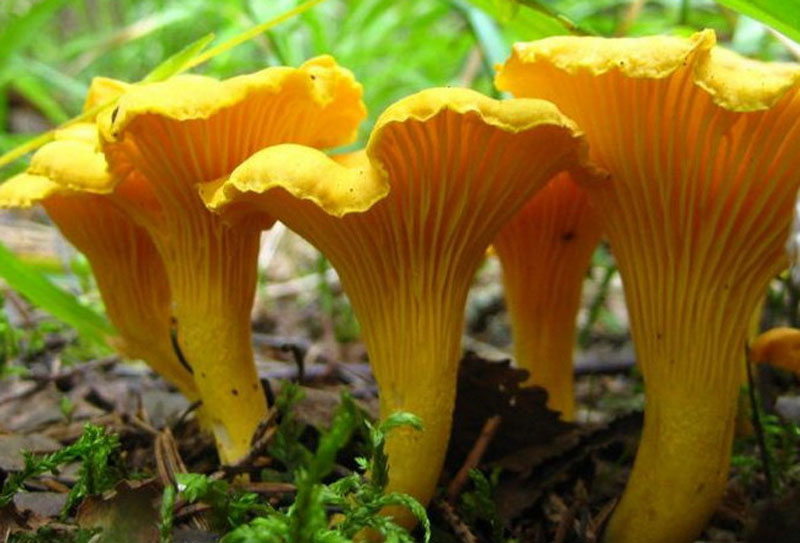
Edible species of chanterelle mushrooms
Mushrooms have unusual taste that other mushrooms do not have. This uniqueness makes the gift of the forest desirable for amateurs. quiet hunting... In spite of General characteristics families, there are different kinds one mushroom.
The common species has become quite popular among all subgroups. This variety belongs to the edible and useful finds of foresters. Its upper dome usually grows and increases in size. In the family you can find different heads: from 2 to 10 cm. The color of the hat merges into red. On close inspection, it allows you to see a different range. Starting from a pale yellow tone, ending with a dark bright orange. It tastes a little sour.
The skin is difficult to separate from the body. The pulp is yellow at the edges, paler by tone at the cuts. The leg is the same color as the dome head. Its thickness is 1-3 cm, and its length is 4-7 cm. It is important to know that due to the presence of the quinomannose substance in the pulp, the fungus does not attract pests, worms, insects bypass the forest gift. This subspecies usually grows in deciduous and coniferous forest belts. Growth time is the beginning of summer (June) and until the end of August.
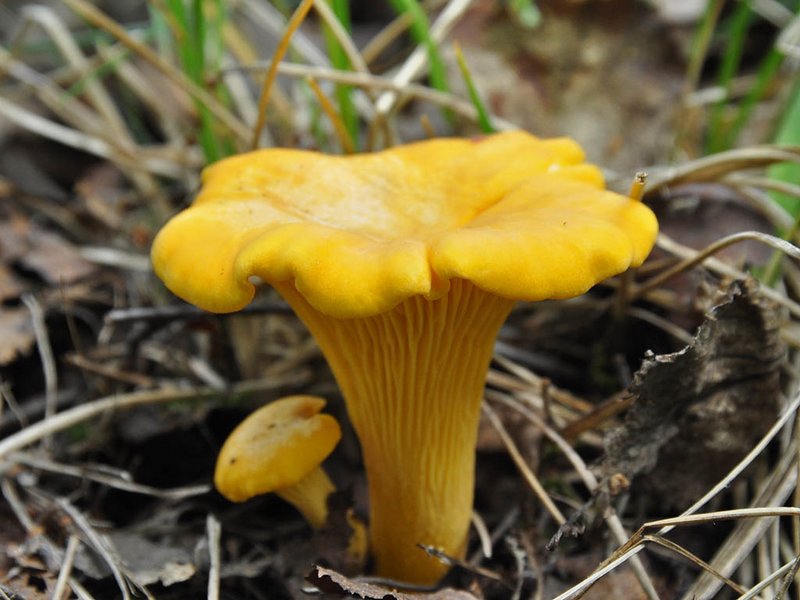
Chanterelle white
Mushroom pickers also call these subgroups "light" or "pale". This kind belongs to edible and healthy varieties.
- The volume of the white chanterelle's cap is usually from 2 to 5 cm, but there are also "giant" domes, the size of which reaches 10 cm. Distinctive feature the white chanterelle is the shape of the cap. It is funnel-shaped with sinuous edges. The leg of the mushroom is yellowish. In length up to 5 cm, and in thickness up to 1-2 cm. The bottom of the leg usually resembles a cylinder, the top is tapered.
- The pulp of this subspecies is dense. Unfortunately, this is a rather rare variety.
It is not so easy to meet them, however, they are very tasty, so they are looked for, hoping for a successful result.
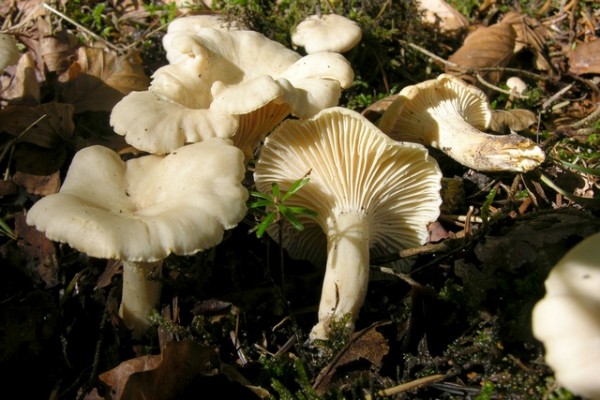
Chanterelle white
Black chanterelles
This is a distant relative of the common chanterelle. However, they are very different in appearance. The mushroom is dark in color, resembling soot or charcoal in description.
- The diameter of the upper part reaches 8 cm. The pulp is tubular. The edges are uneven. The base is 1–2 cm long, gray in color. Stiff leg, slightly narrowed at the mycelium.
- Spore powder is white. The body of the black chanterelle is gray, brittle and absolutely does not smell.
The harvesting season for the black chanterelle begins in July and ends in September. It grows in deciduous or mixed forests. They grow in small groups.
How to distinguish a false fox from a real one (video)
Faceted chanterelle
This mushroom is very common in the forests of North America. The body shape of the faceted chanterelle is funnel-shaped, with a diameter of 3 to 10 cm and has a dark orange color.
- Top part similar to a hat with wavy and hanging down edges. Although the flesh of the mushroom is quite dense, it is very fragile and with a rather pleasant smell.
- The size of the leg is about 2 - 2.5 cm. The mushroom can grow both in groups and singly. The season of the faceted chanterelle begins in summer and ends in early fall.
Faceted has some special food qualities. The fact is that it includes paintings, thanks to which it prevails over some edible mushrooms and even some vegetables.
In addition, this type of chanterelle has a number medicinal properties and qualities. It is used by obese people. Some substances from the content of the faceted variety help with acute inflammations. It has immunostimulating and antitumor properties.
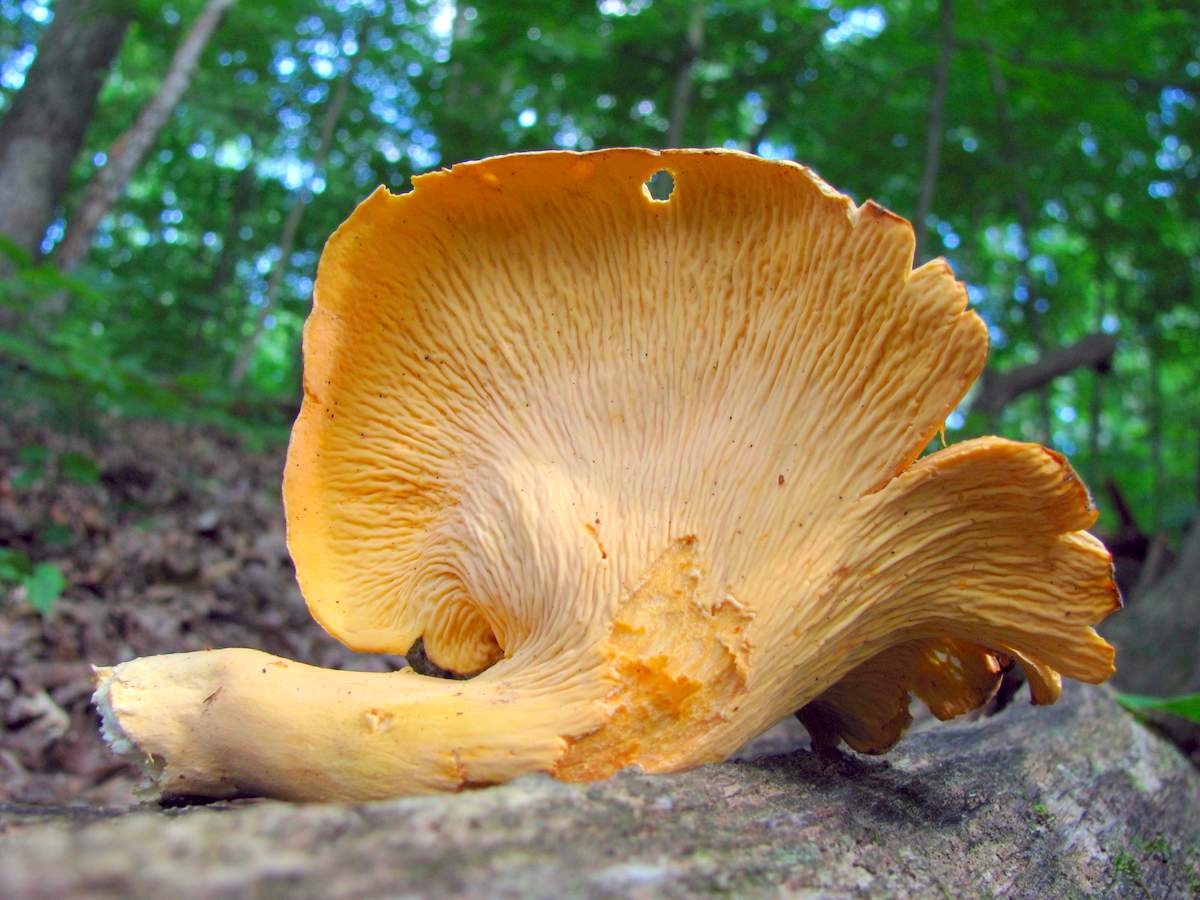
Faceted chanterelle
Such a group has several more lows: the lobe is tubular, funnel-shaped. The upper part is small in size, usually reaching 5 cm. If the mushroom is young, then its cap is even, slightly convex. In adult specimens, it is already more acute, has a funnel-shaped shape.
- The skin is covered with small scales, to the touch it is similar to a dark velvet fabric. The tone of the hat is always different, rarely in the same family - one color. It is both dark, yellow and bright orange. It has various shades from the brown color palette.
- The base of the mushroom bowl is cylindrical, thin in volume, sometimes curving. In height it reaches from 3 to 8 cm. In thickness - from 5 to 10 cm.
- The color of a thin leg can be light yellow, however, in the place where the cap passes into the leg, the shade is always darker, which is noticeable even with the naked eye.
- The flesh is firm, but very thin. Usually yellow or white tint... In addition, the flesh of a young tubular chanterelle is very tasty and has an unusual aroma. The pulp in an adult specimen is bitter.
You can find such a chanterelle in northern forests with a temperate climate. Usually these are coniferous forests. They grow in the shade or on moist soils. It is difficult to find her, as she hides among the moss and grass. Begins to bear fruit in August, the latter are found in September. You can cook from this variety tasty soup, prepare dry powder, fry, marinate or freeze for the winter. It is considered a delicacy.
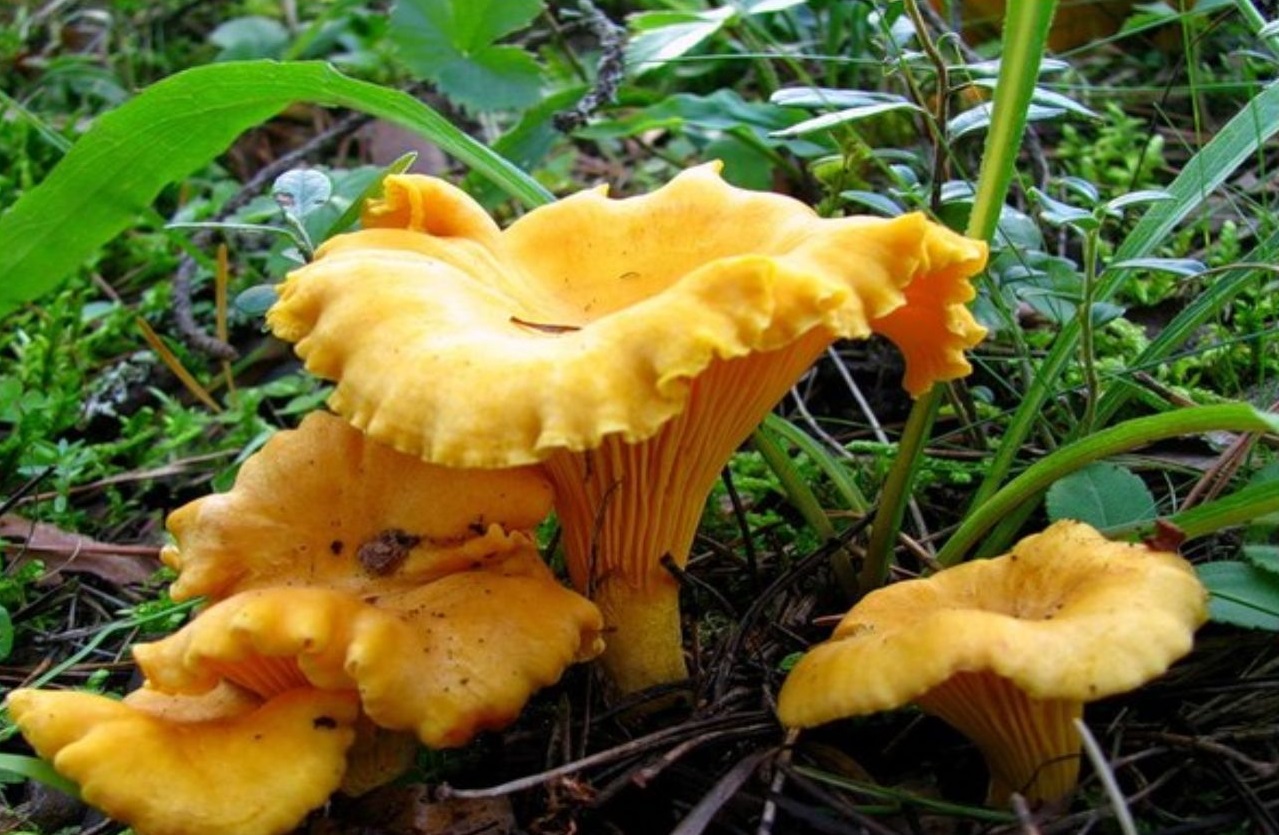
Chanterelle velvety
This type of chanterelle is very rare.... It is edible.
- The hat of this species is velvety. It measures from 4 to 5 cm. In small finds, the dome is convex, while in adults it transforms and becomes more like a funnel.
- In height, the leg is small 2-3 cm, rarely, but it can rise up to 7 cm.At the ground, it is slightly narrowed.
- The color of the cap is always different. It can be either bright orange, red or light yellow. Due to the fact that the edges of the cap are wavy, the mushroom becomes curly. The content of the mushroom is delicate and velvety. It has a pleasant aroma, but it tastes a little sour.
Velvety is a lamellar species. The plates are thick and rough. There are streaks between them. This mushroom is very demanding on the climate and soil. You can find them in the southeast of the European Territories. They are usually harvested from mid-July to October. Value nutritional characteristics such a forest find is as high as possible. They are very often used in culinary recipes, they are saturated with medicinal ingredients and a special pleasant taste. Chefs prepare real masterpieces from them.

Chanterelle velvety
Yellow chanterelles
The hat of this type is orange-yellow, and sometimes the color of egg yolk.
- The dome is convex, elongated and flat, depending on the growth time. The size of the upper part is from 5 to 10 cm.
- The skin is smooth to the touch, with wavy, rounded edges.
- The flesh of the body of the mushroom is dense and always the same color as the dome.
It tastes different from others: a little spicy, with a pleasant forest smell. The spore powder becomes yellow after processing. The harvesting season for this subspecies begins in June and ends in late autumn. Grow in forests with different types trees: mixed and deciduous forest areas. They hide in mosses, grass, on damp soils.

Yellow chanterelles
How to distinguish between false and true chanterelles
As it turned out, the chanterelle is a very cunning mushroom that explains its name. You need to know very well its characteristics in order to distinguish poisonous false foxes from true edible representatives of the family.
- The first difference is in color and shape. You can immediately determine false mushroom or not. The real color is usually attractive: yellow, orange, cream. False look very bright, defiant and frightening. These are usually brown, fiery orange hues.
- You can also distinguish a false chanterelle on the surface of the cap. In the "false fox" it is smooth, even and clean. Up to 6 cm in size. A real chanterelle has a large dome, the shape always does not have the correct outlines, the edges are wavy.
- You can distinguish a chanterelle by the base - the leg. Experienced mushroom pickers first of all, study it for density. If it is thick and rather sturdy, it is a genuine specimen. And if the leg is thin and hollow inside, then this is a dangerous double.
How to cook chanterelles (video)
Nutritional value and useful properties of chanterelles
The nutritional value is very high and the calorie content is low. The fact is that they contain vitamins such as: in A, B2, C, PP. They also contain a lot of manganese, potassium, copper and cobalt. That is why the components make the forest guest healing, universal in the fight against many pathologies. Some of them can be listed:
- night blindness;
- angina;
- obesity;
- furunculosis;
- disorders of the pancreas.
Gallery: chanterelle mushrooms (50 photos)
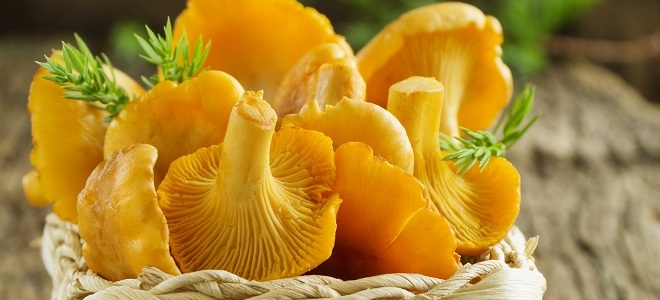
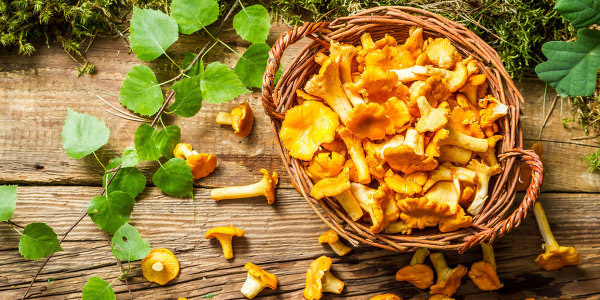
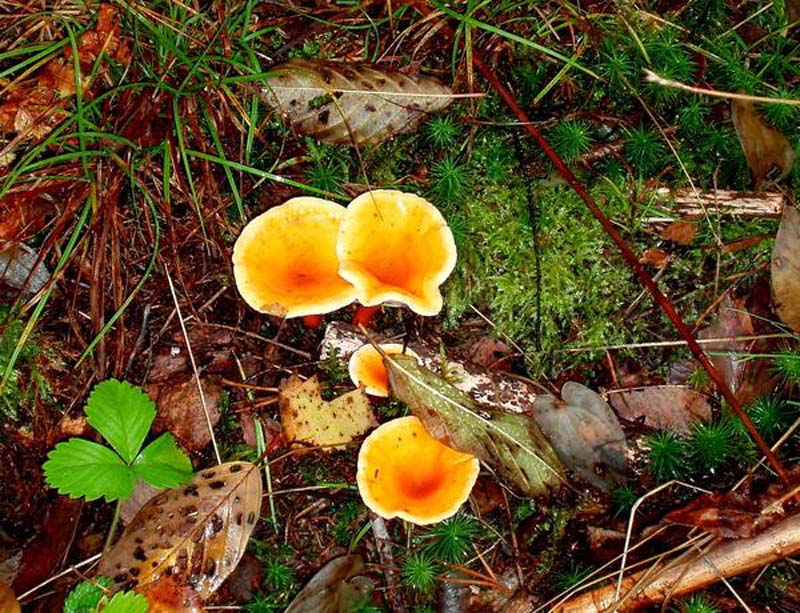
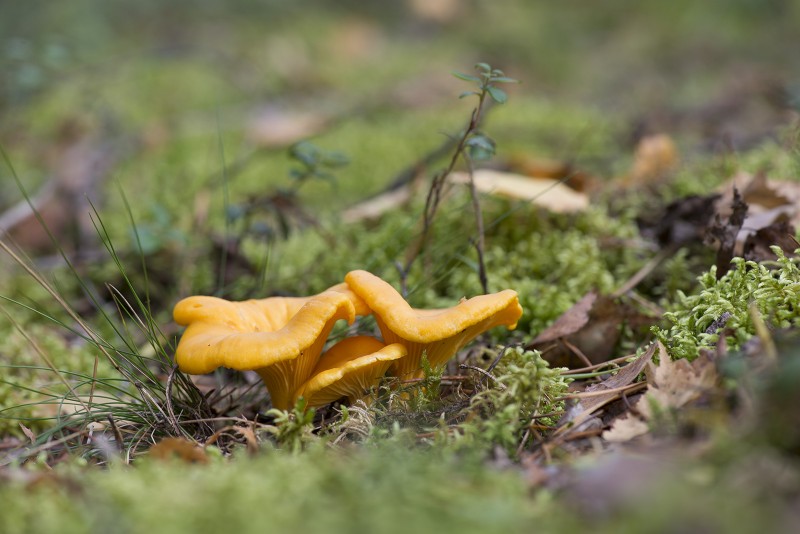
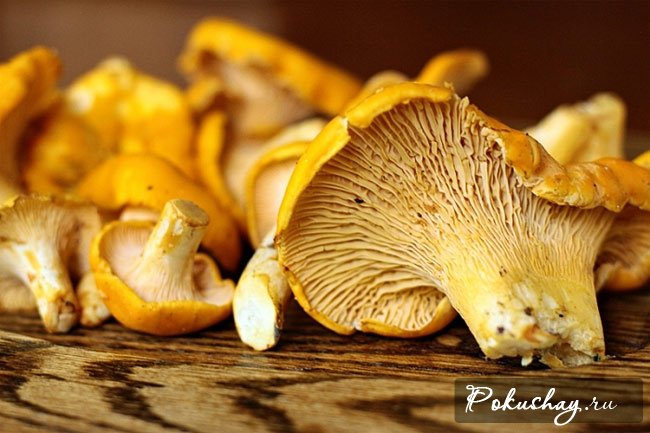
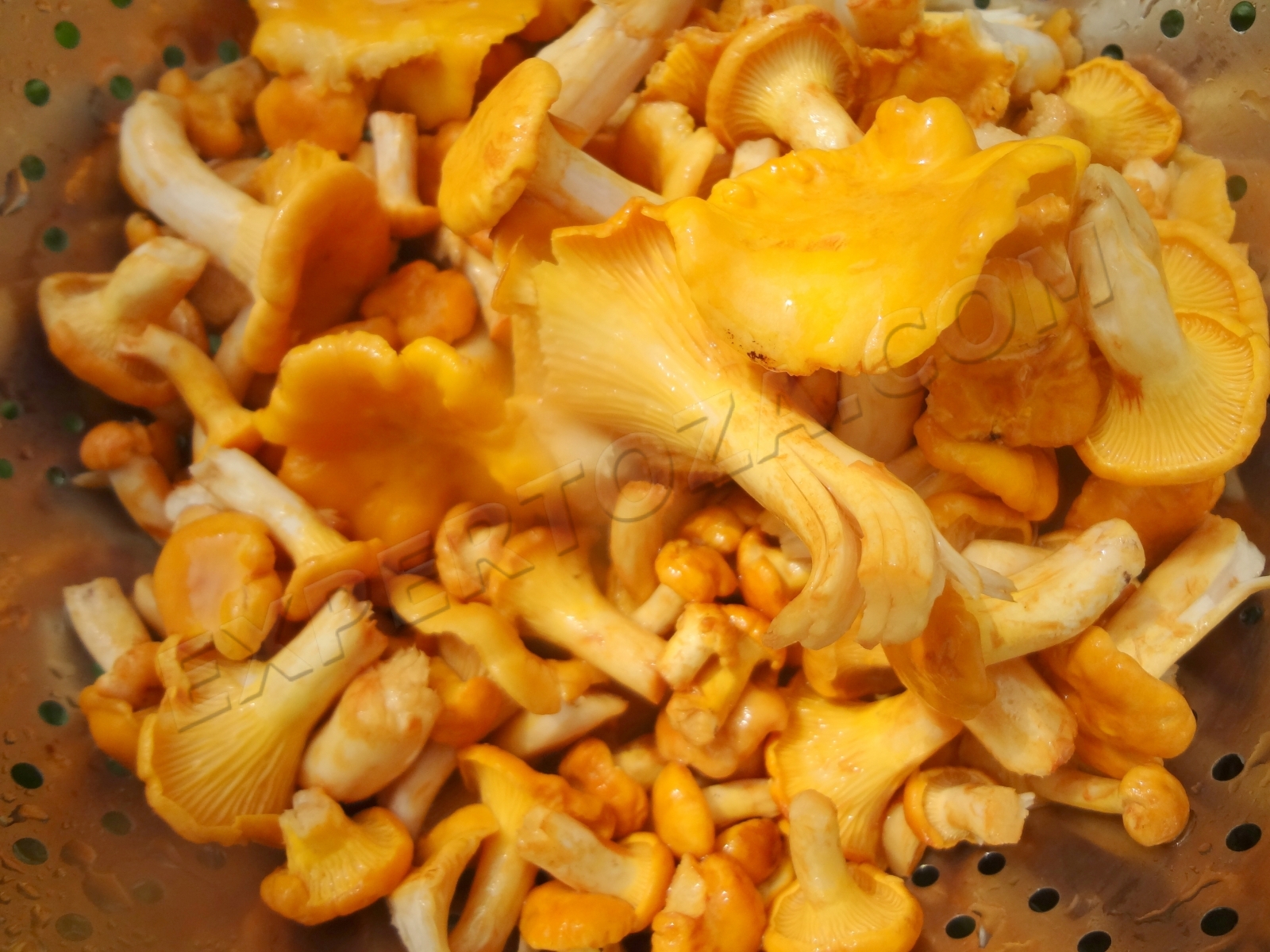
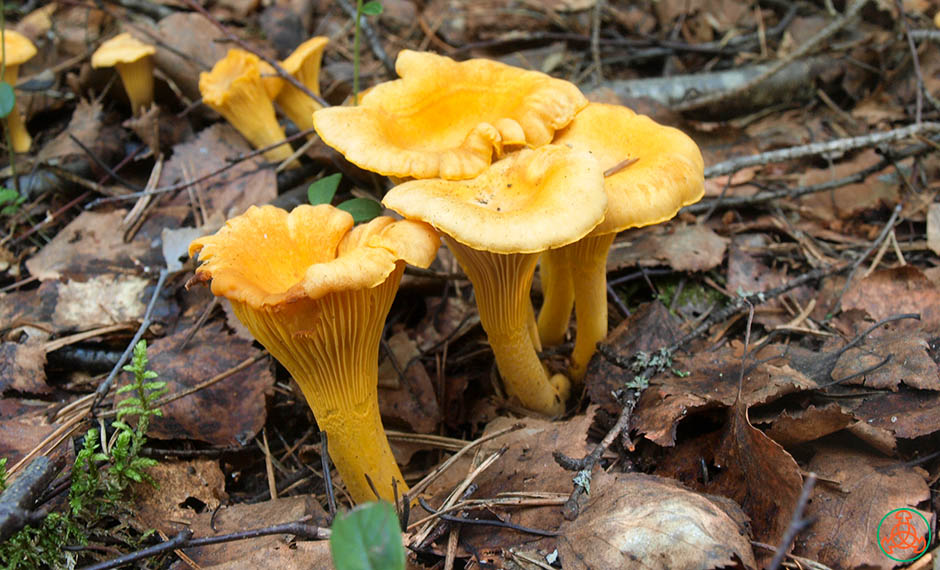
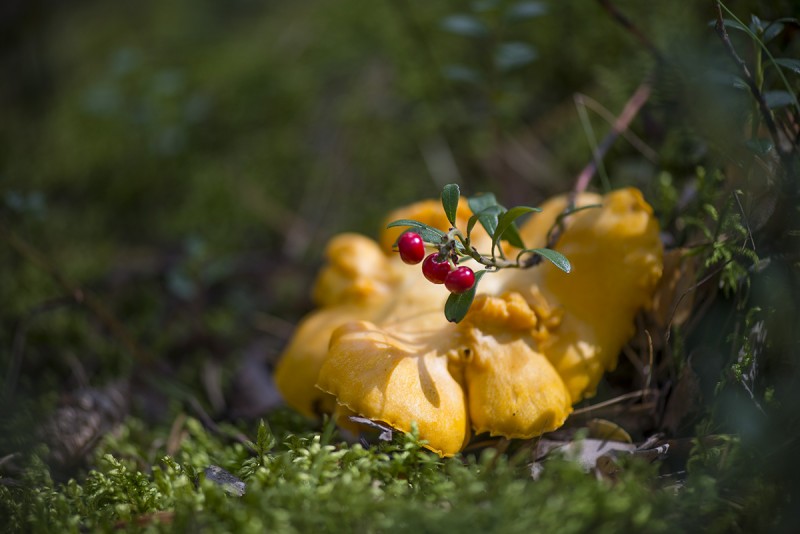
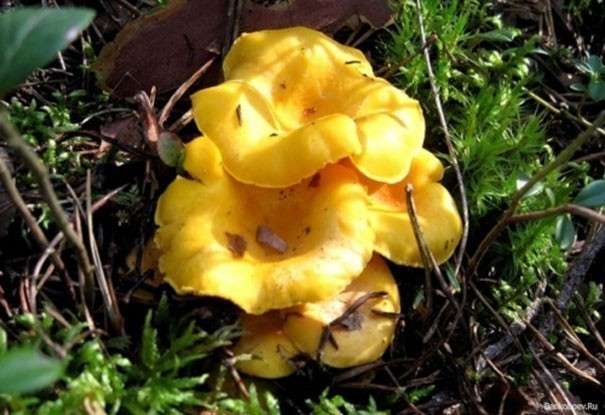
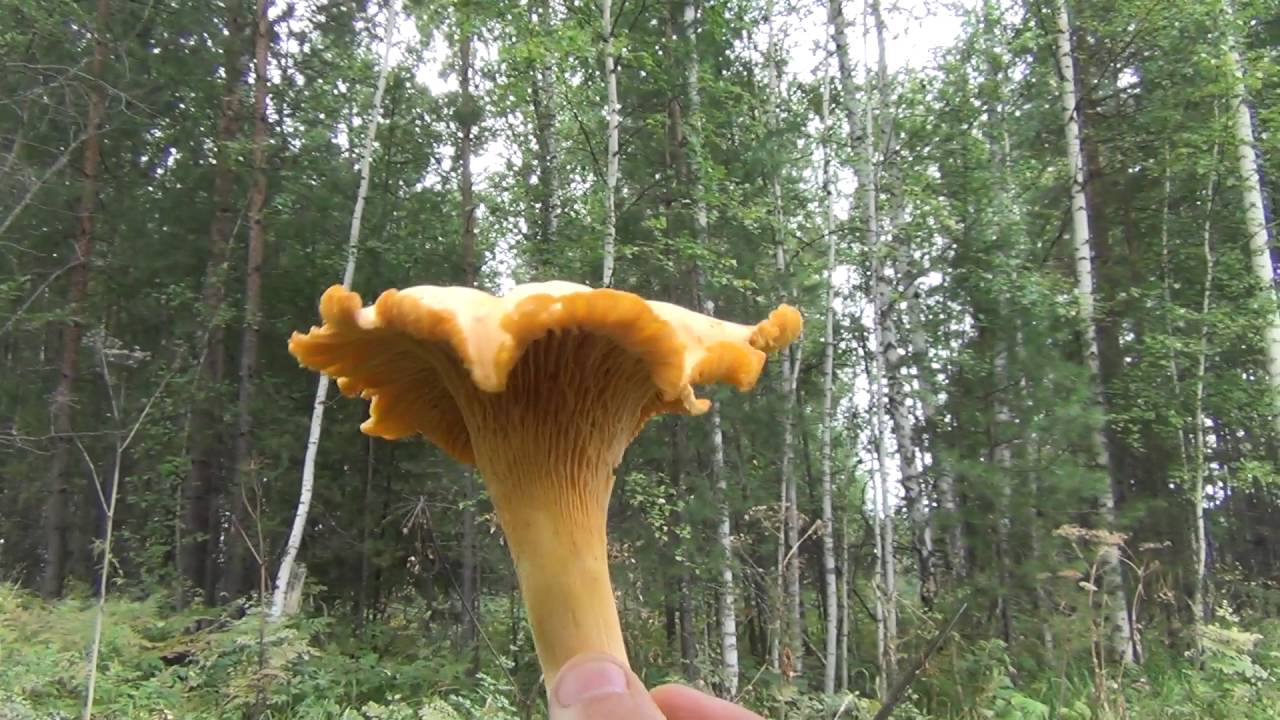
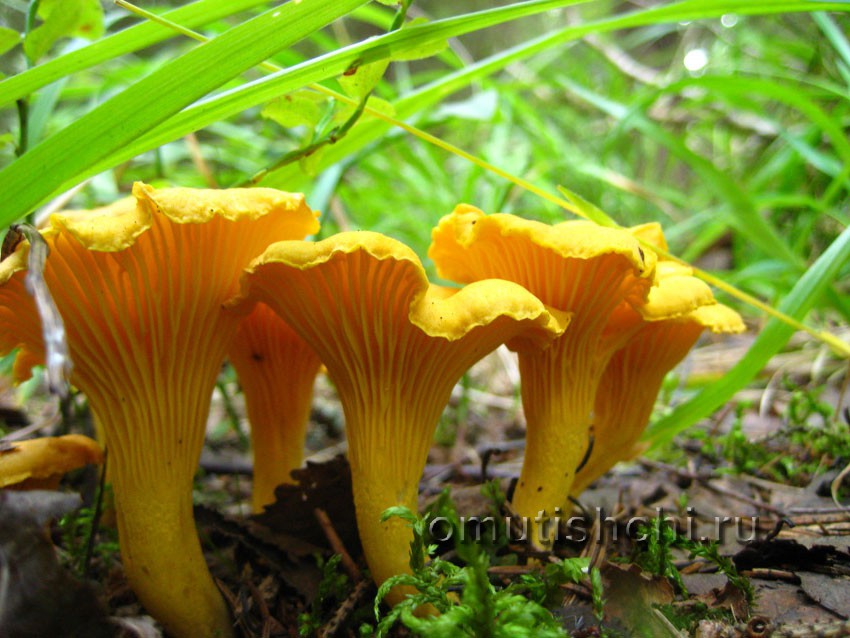
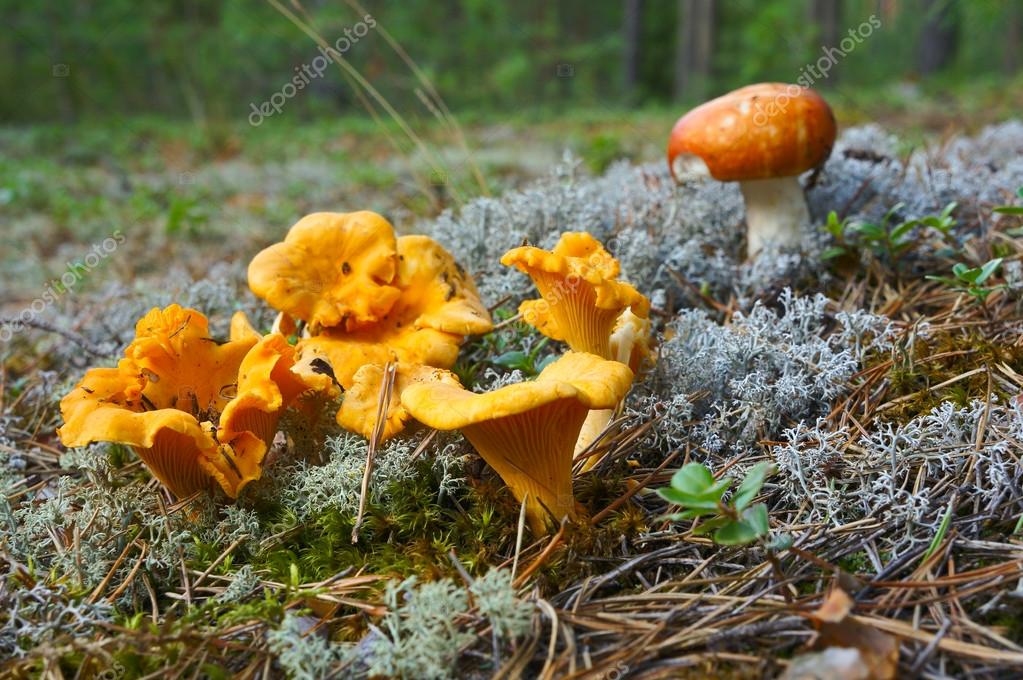
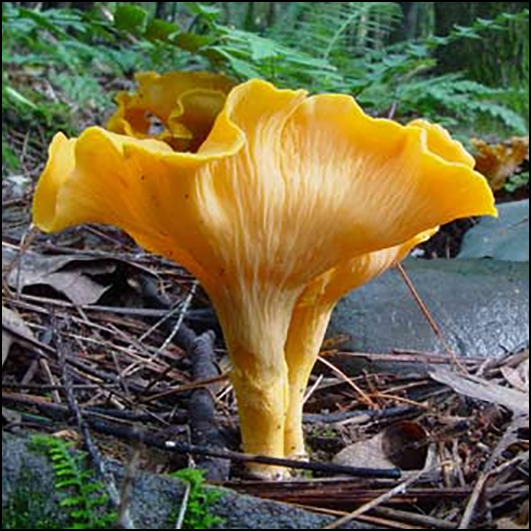
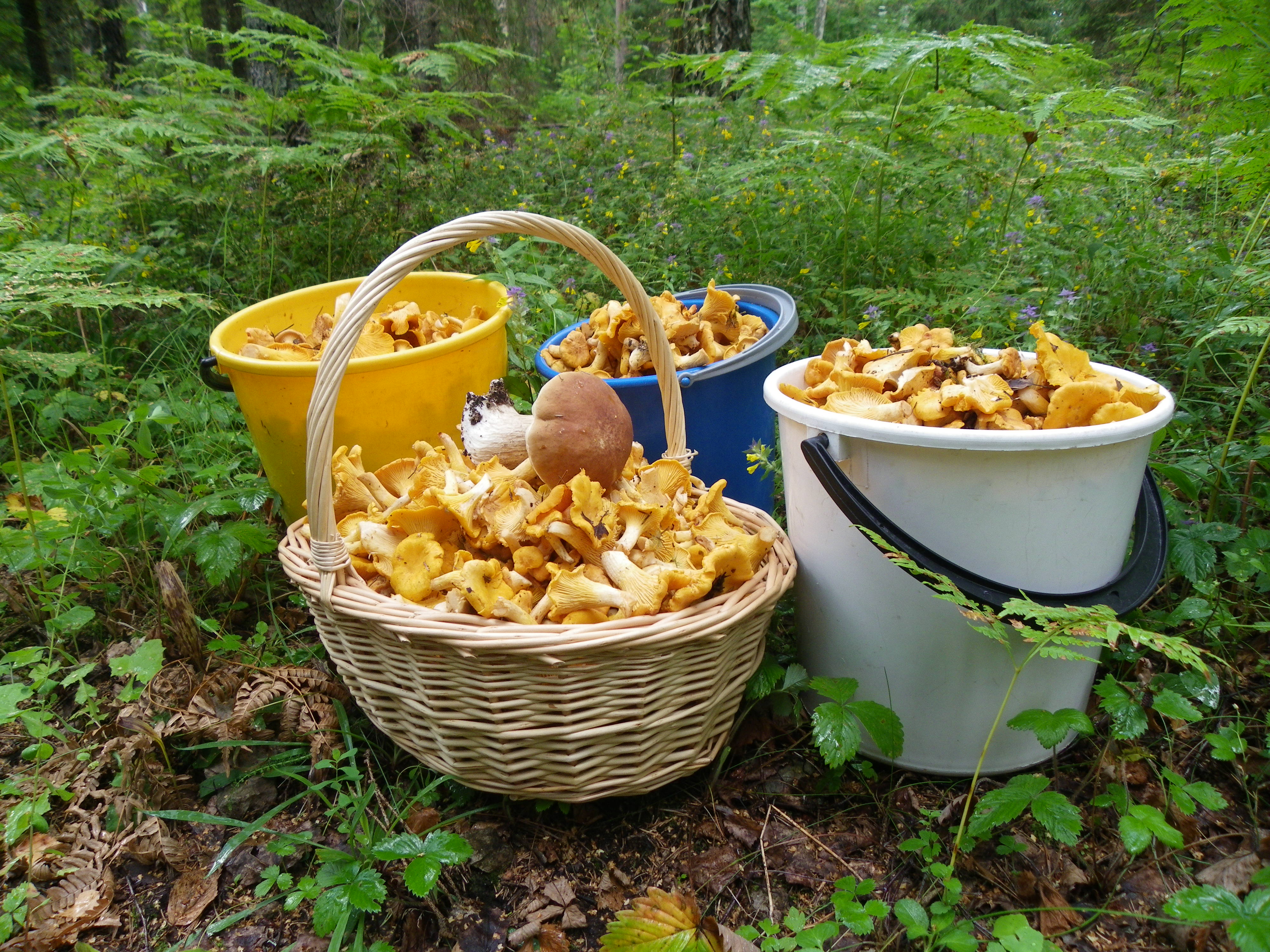
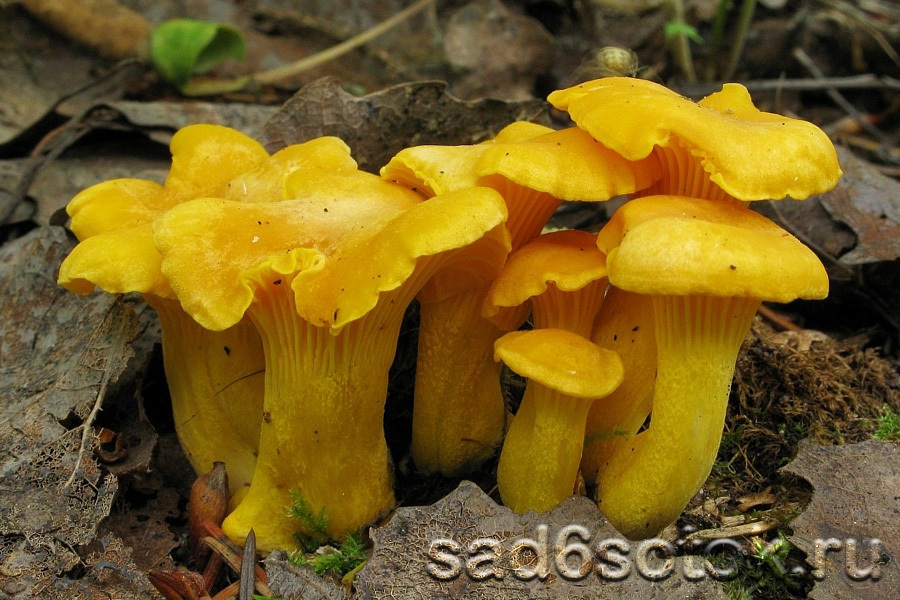
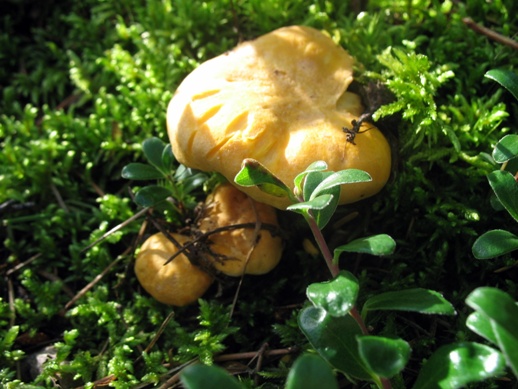
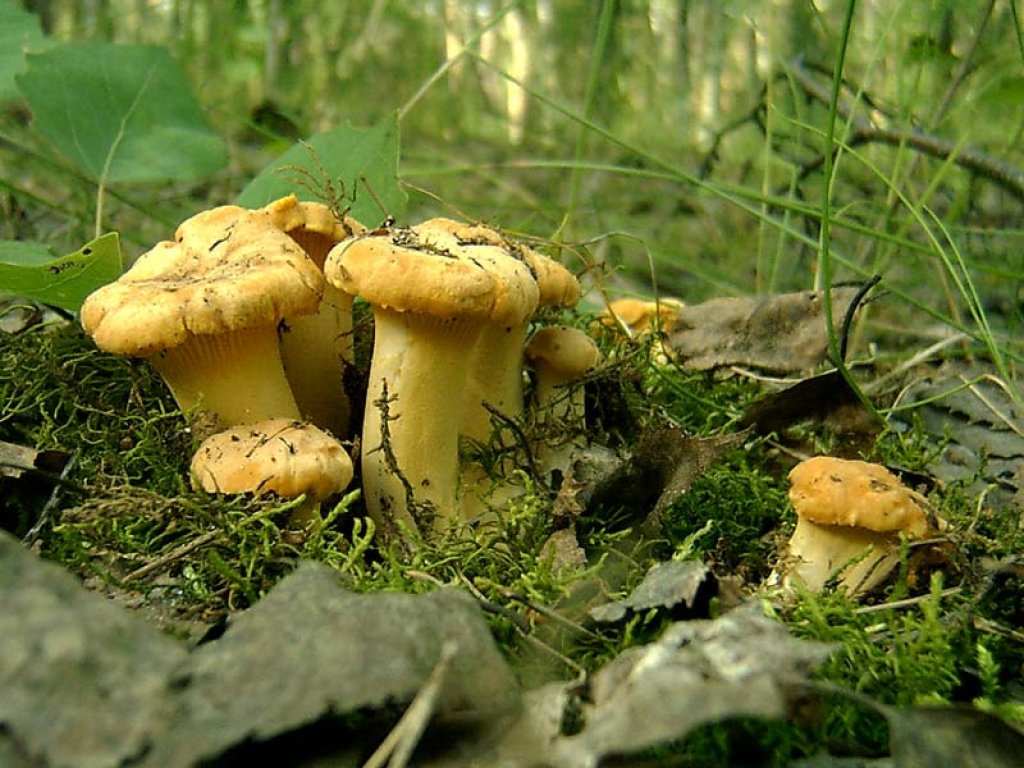
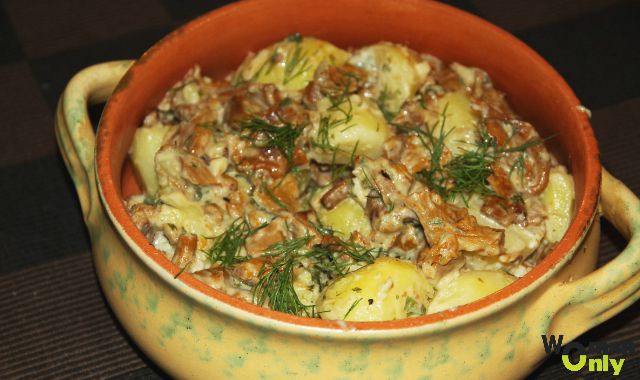
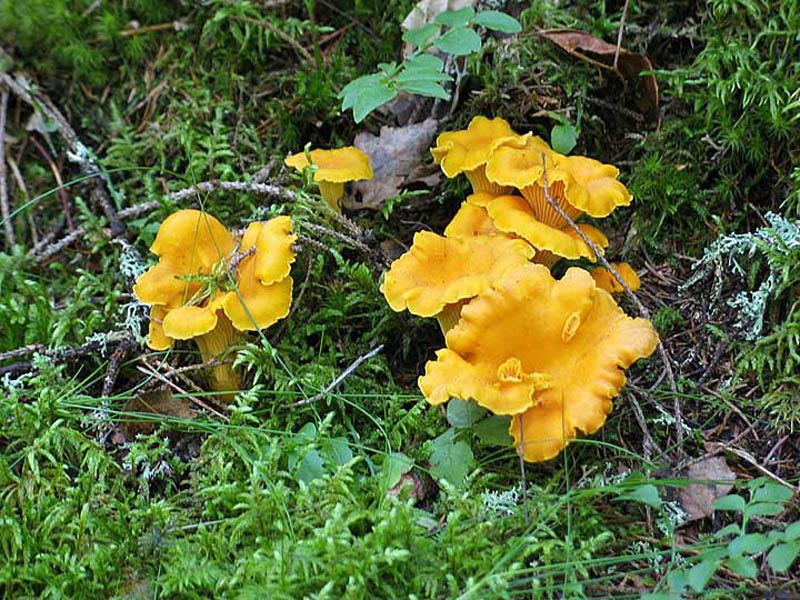
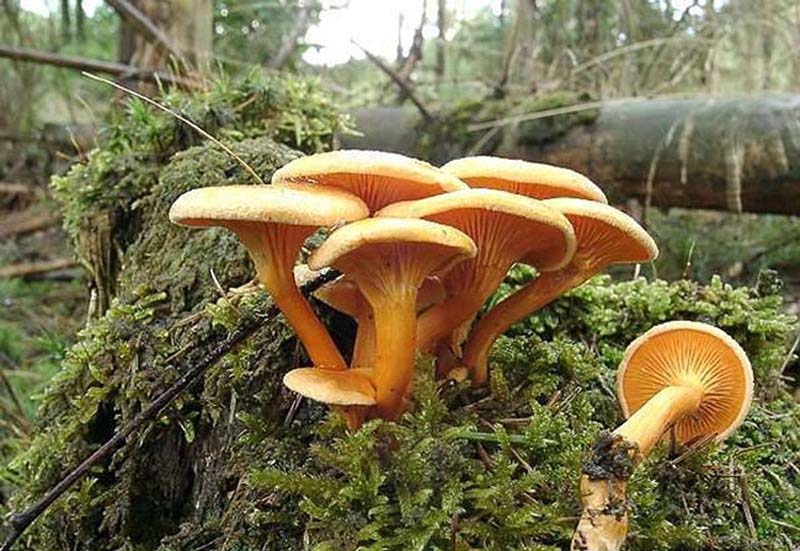
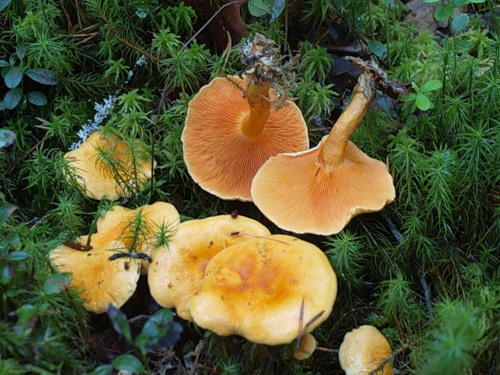
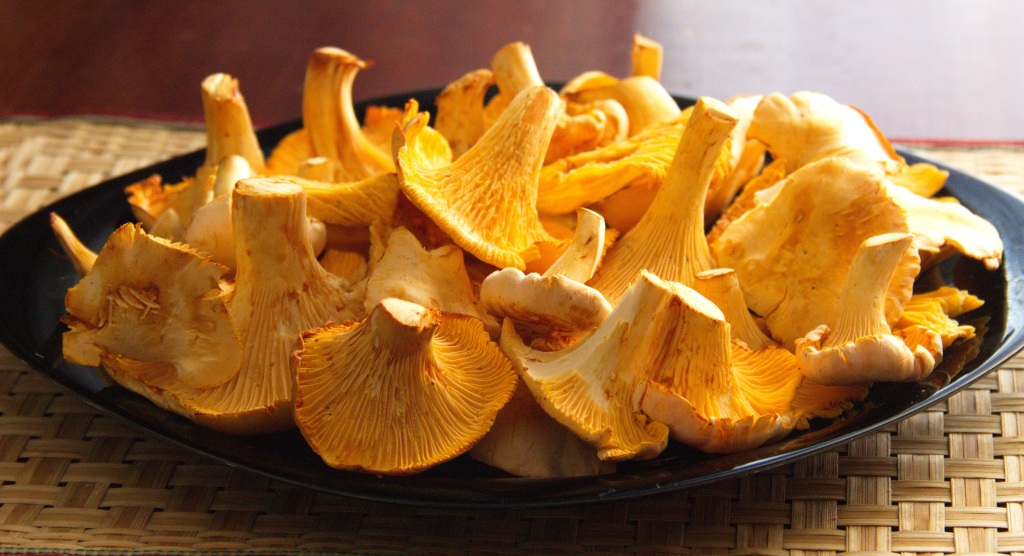
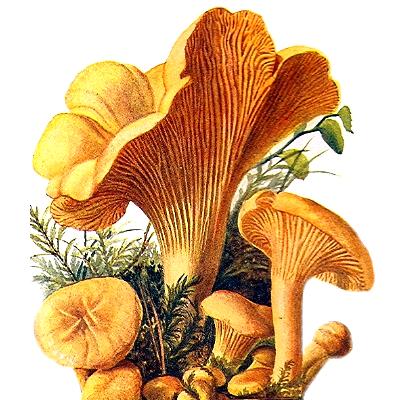
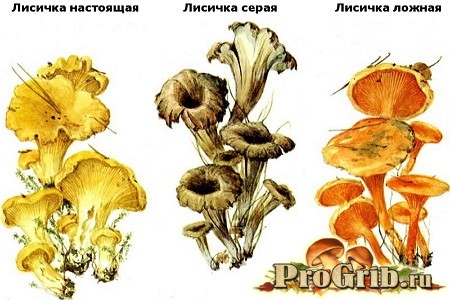
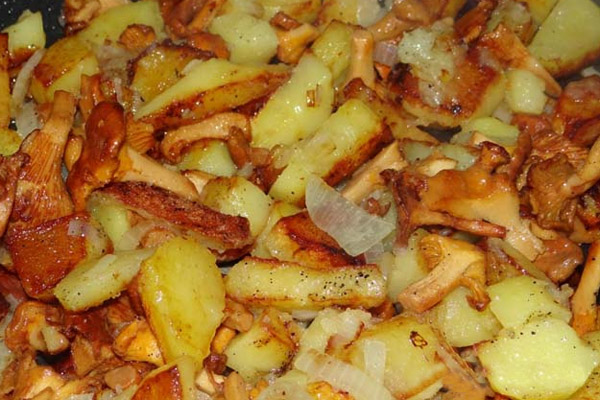
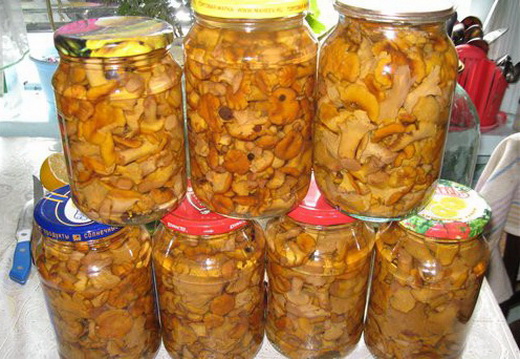
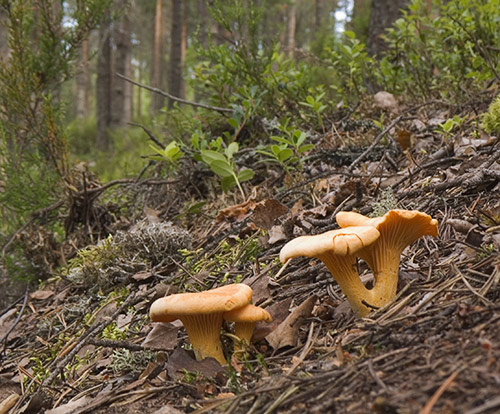
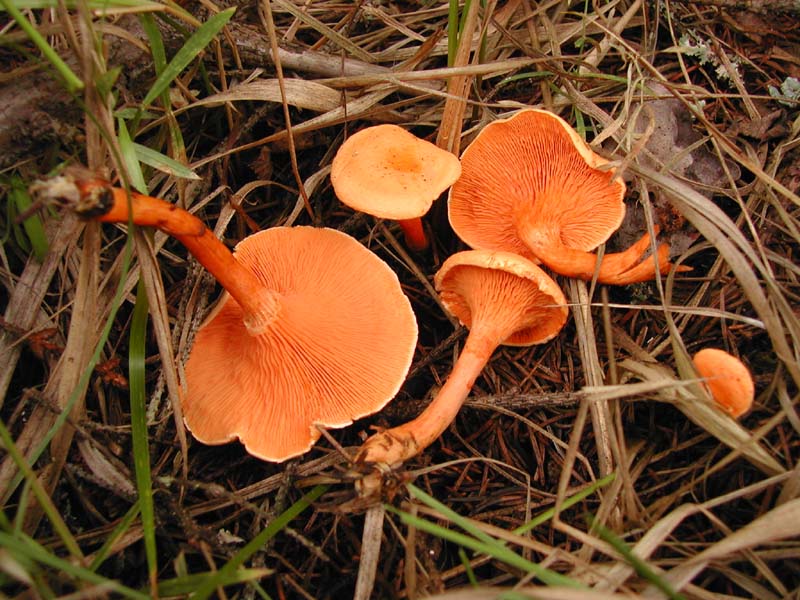
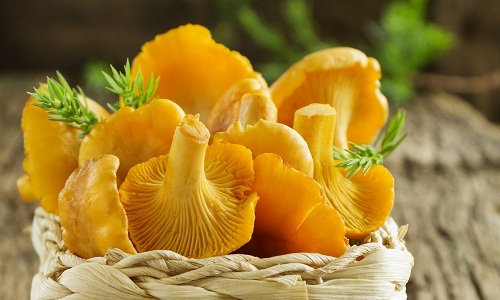
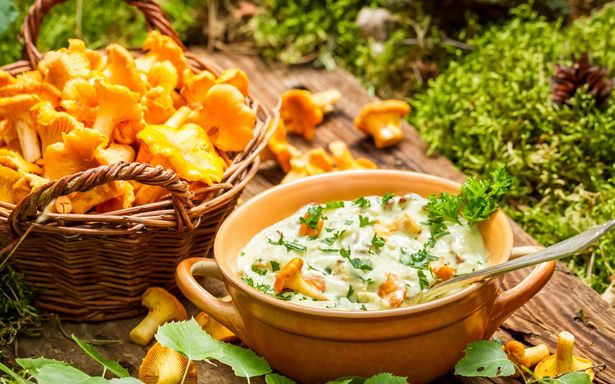
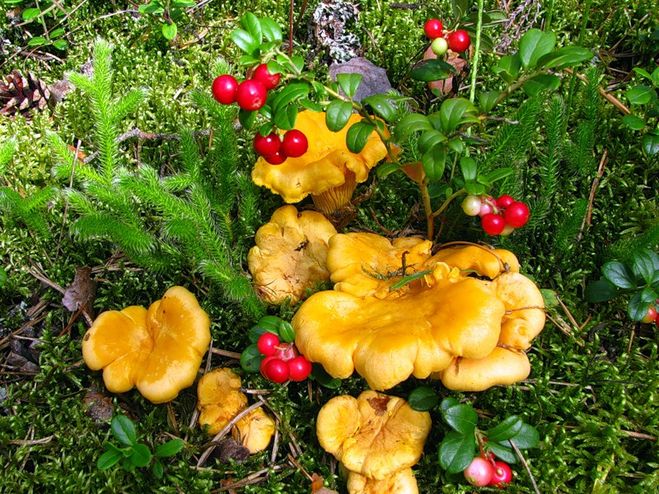
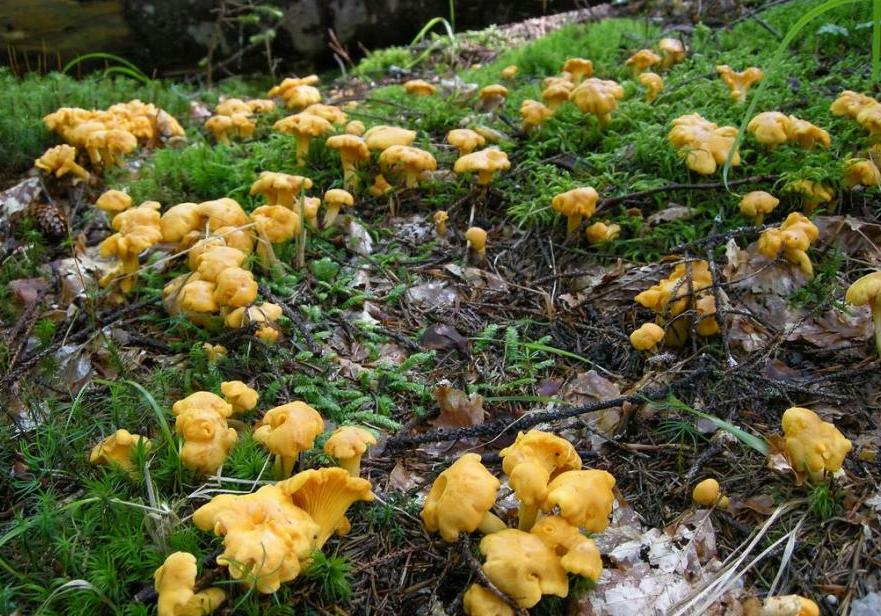
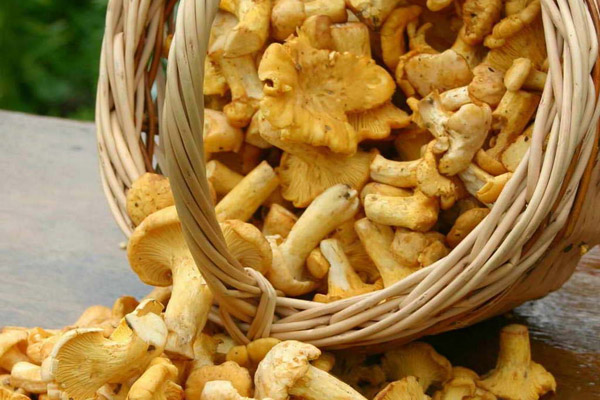
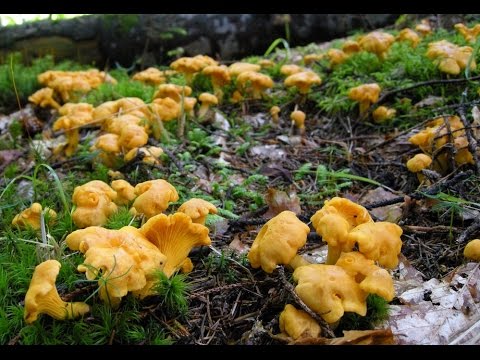

![]()
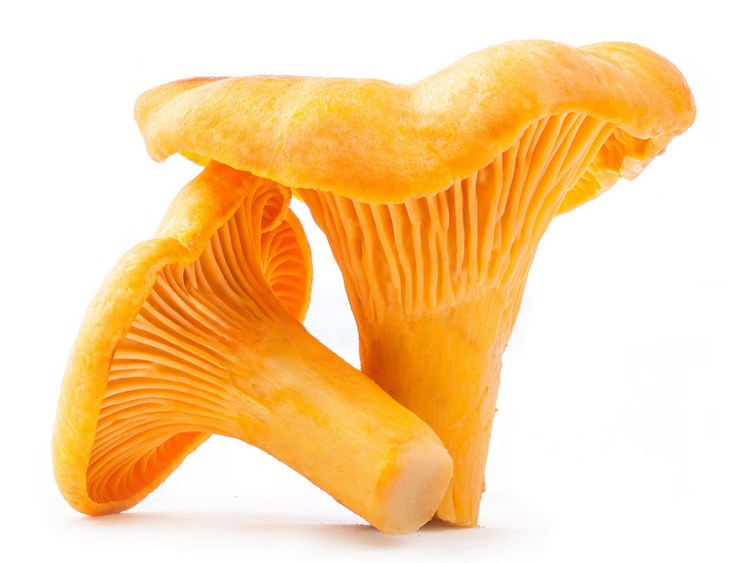
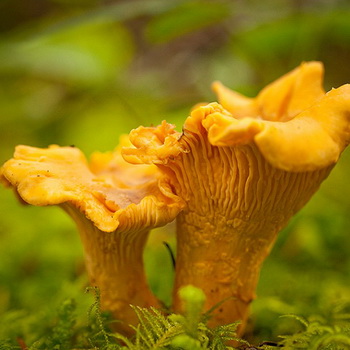


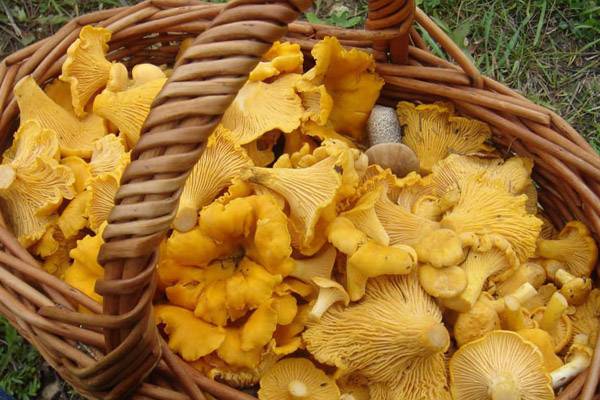
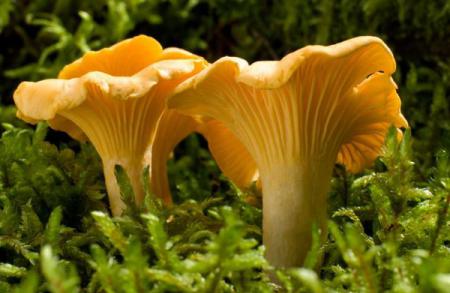

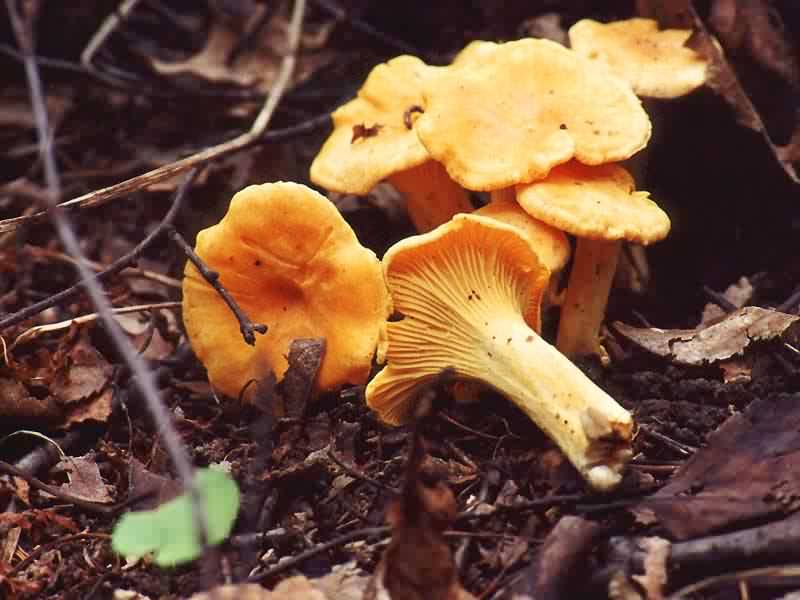
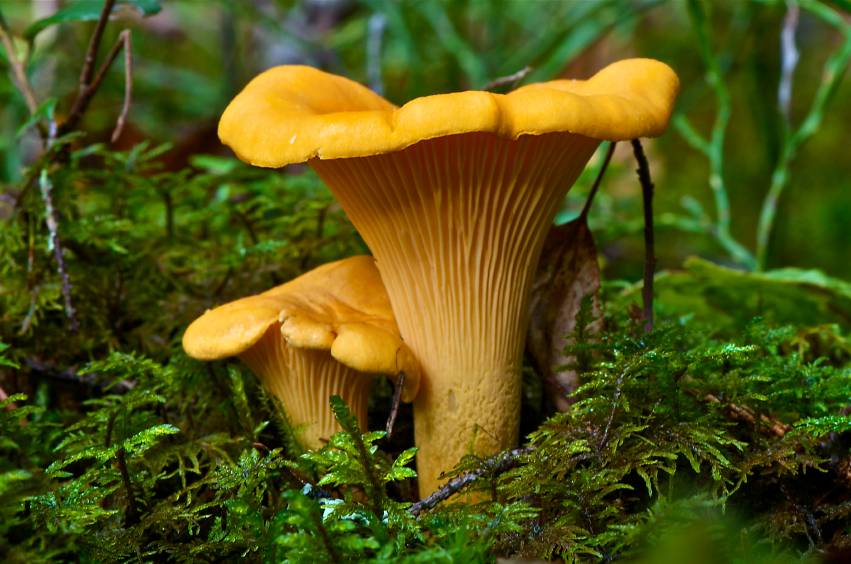
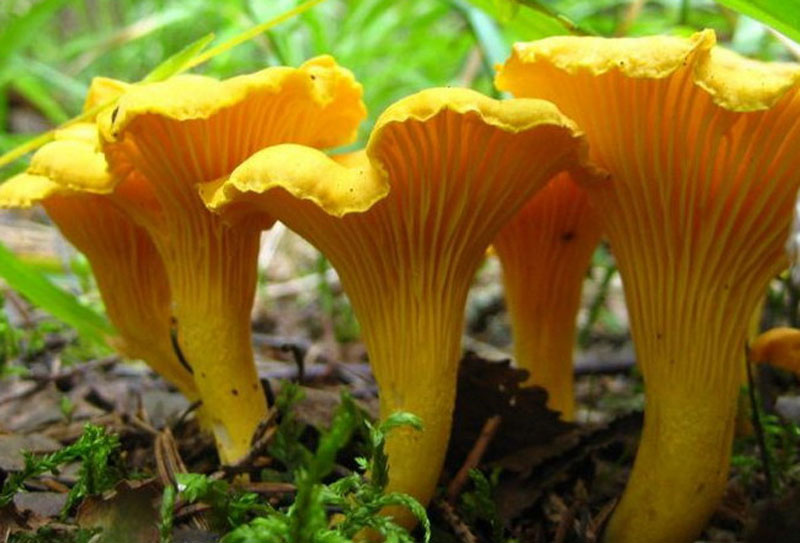
Chanterelles (lat. Cantharellus) are mushrooms that belong to the Basidiomycete department, Agaricomycete class, Cantarella order, Chanterelle family, Chanterelle genus. These mushrooms are difficult to confuse with others, as they have an extremely memorable appearance.
Chanterelles - description and photos.
The body of chanterelles in shape resembles the body of cap-pedunculate mushrooms, however, the cap and leg of chanterelles are one whole, without visible boundaries, even the color is about the same: from pale yellow to orange. The cap of the chanterelle mushroom is 5 to 12 centimeters in diameter, irregular in shape, flat, with curled, open wavy edges, concave or depressed inward, in some mature individuals it is funnel-shaped. People call such a hat "in the shape of an inverted umbrella." The chanterelle's cap is smooth to the touch, with a hard-to-peel skin.
The flesh of chanterelles is fleshy and dense, fibrous in the area of the leg, white or yellowish in color, has a sour taste and a mild smell of dried fruits. When pressed, the surface of the mushroom turns reddish.
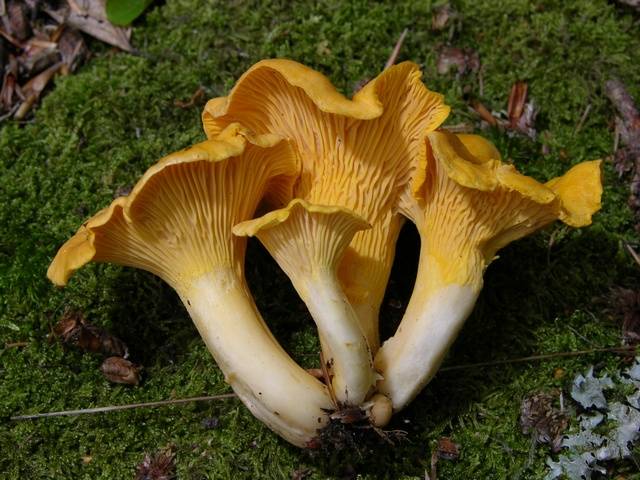
The leg of the chanterelle is most often the same color as the surface of the cap, sometimes somewhat lighter, has a dense, smooth structure, homogeneous in shape, slightly narrowed to the bottom, 1-3 centimeters thick, 4-7 centimeters long. The surface of the hymenophore is folded, pseudoplastic. It is represented by wavy folds falling along the leg. In some species of chanterelles, it can be venous. The spore powder has a yellow color, the spores themselves are ellipsoidal, 8 * 5 microns in size.
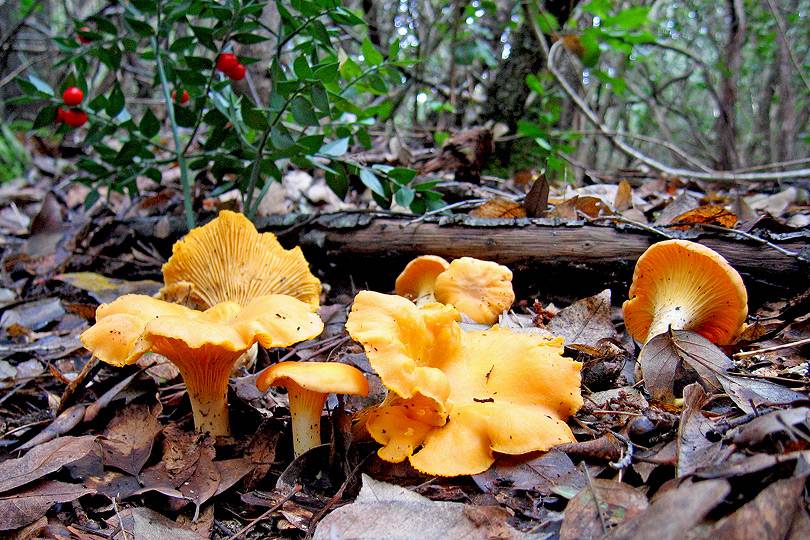
Where, when and in what forests do chanterelles grow?
Chanterelles grow from early June to mid-October, mainly in coniferous or mixed forests, near spruces, pines or oaks. They are found more often in damp areas, in temperate forests among grass, in moss or in a pile of fallen leaves. Chanterelles often grow in numerous groups, appear en masse after thunderstorms.
Chanterelle species, names, descriptions and photographs.
There are over 60 species of chanterelles, many of which are edible. Poisonous chanterelles does not exist, although there are also inedible species in the genus, for example, the false chanterelle. Also, this mushroom has poisonous counterparts - for example, mushrooms of the genus omphalot. Below are some of the varieties of chanterelles:
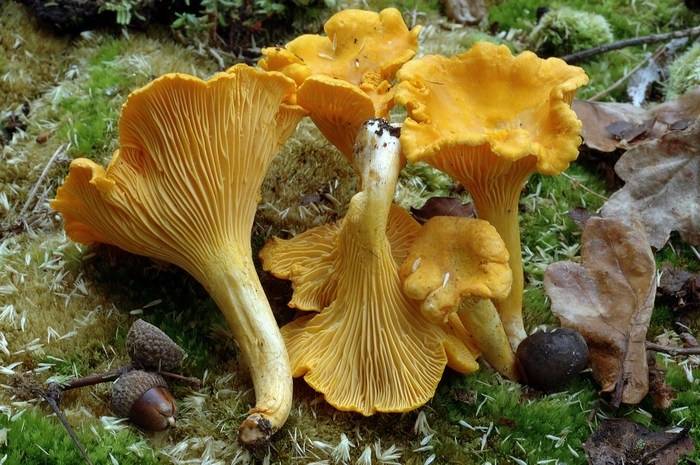
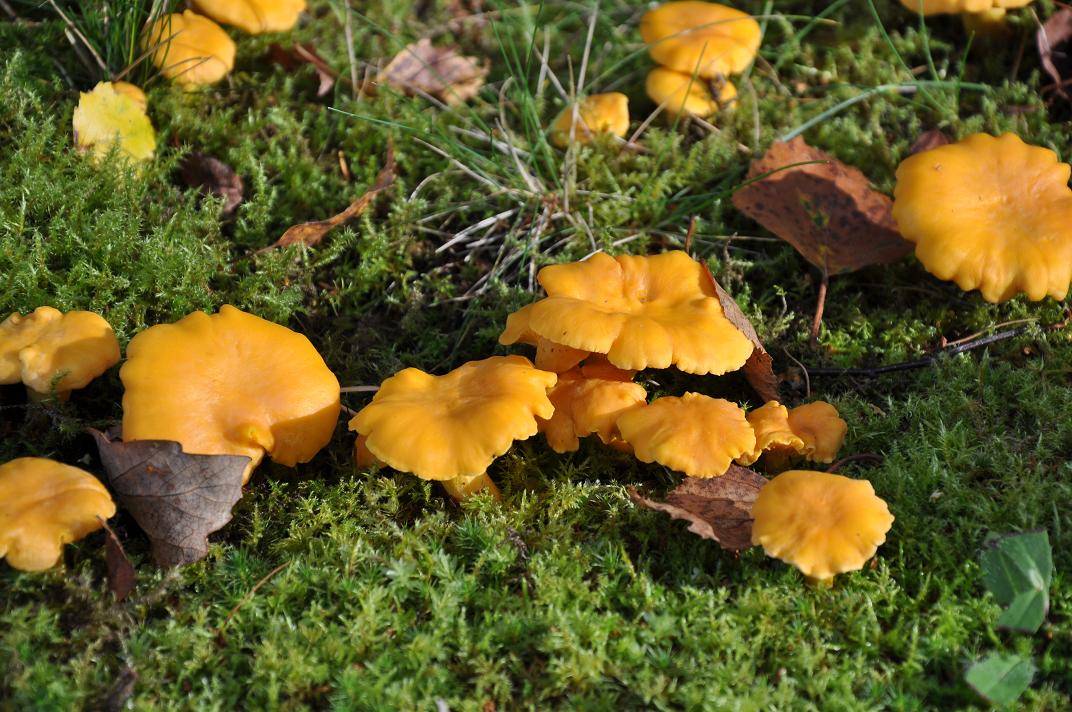
- - an edible mushroom of gray or brown-black color. The hat has a diameter of 1-6 cm, a leg height of 3-8 cm, and a leg thickness of 4-15 mm. The leg is hollow inside. The cap has wavy edges and a depression in the center; the edges of the cap are ash gray. The pulp is firm, gray or brownish in color. The hymenophore is folded. The taste of the mushroom is inexpressive, without aroma. The gray chanterelle grows in mixed and deciduous forests from late July to October. This mushroom can be found in the European part of Russia, Ukraine, America and countries Western Europe... The gray chanterelle is known to few, so mushroom pickers avoid it.
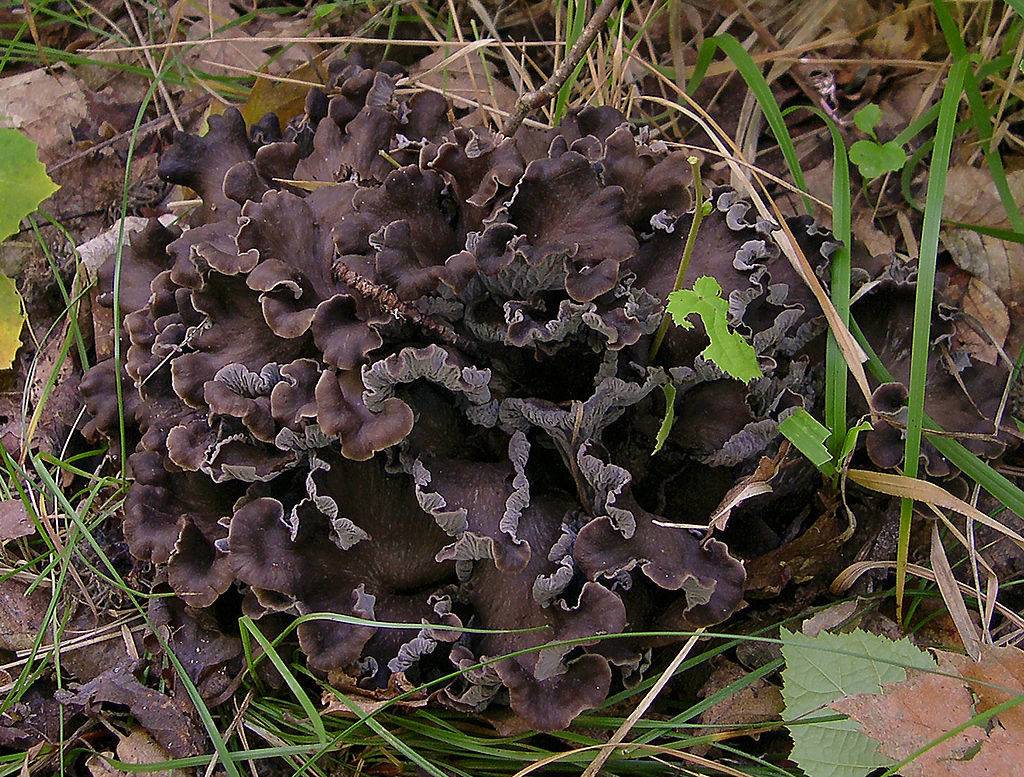
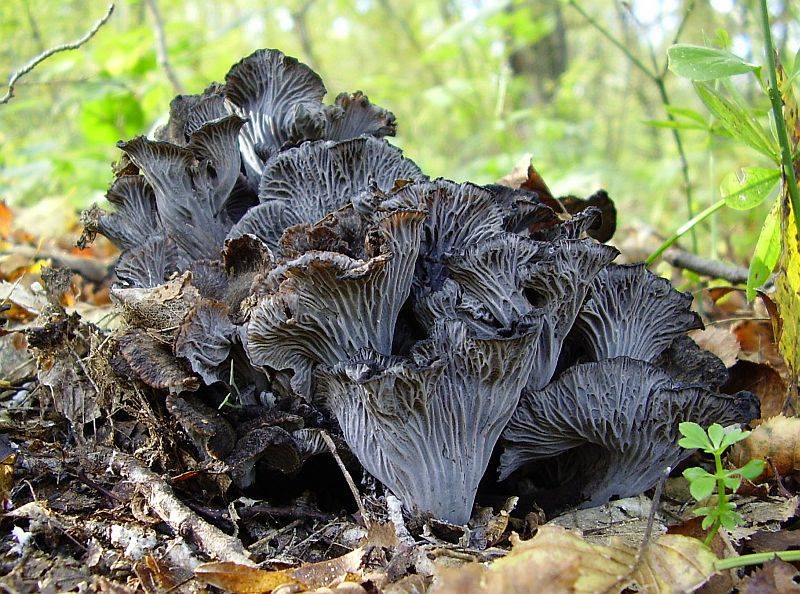
- - Edible mushroom of reddish or pinkish-red color. The diameter of the cap is 1-4 cm, the height of the leg is 2-4 cm, the flesh is fleshy with fibers. The edges of the cap are uneven, curved; the cap itself is concave towards the center. The hymenophore is folded. Thick pseudo-plates have pink color... Spore powder pink-cream. The cinnabar red chanterelle grows in deciduous forests, mainly oak groves, in the eastern part North America... The mushroom picking season is summer and autumn.
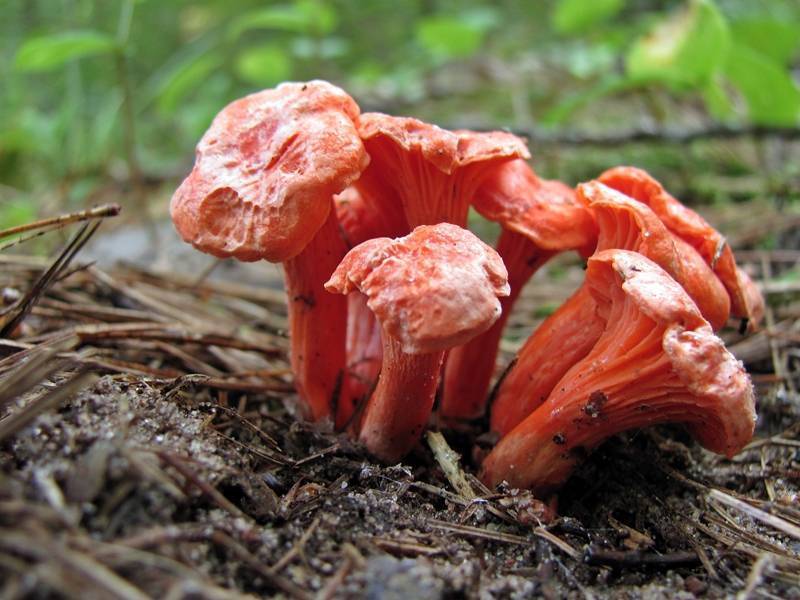
- - an edible but rare mushroom with an orange-yellow or reddish head. The color of the leg is from light yellow to light orange. Hat diameter 4-5 cm, leg height 2-4 cm, leg diameter 1 cm. Hat young mushroom has a convex shape, which turns into a funnel-shaped with age. The flesh of the cap is light orange when cut, whitish-yellowish at the stem. The smell of the mushroom is pleasant, the taste is sour. The velvety chanterelle grows in the countries of southern and eastern Europe, in deciduous forests on acidic soils. The harvesting season is from July to October.
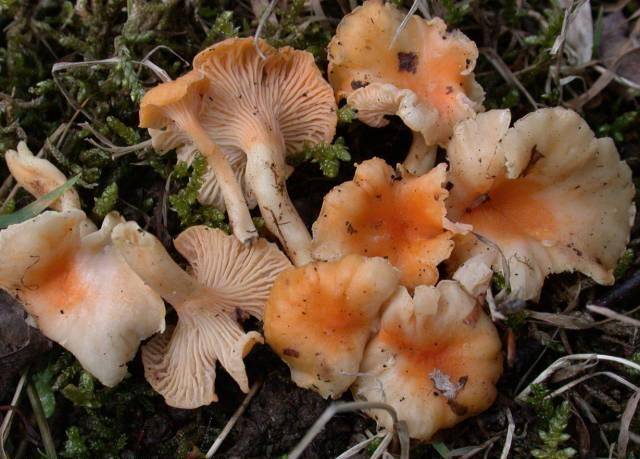
- - an edible mushroom of orange-yellow color. The fruiting body measures from 2 to 10 cm. The cap and stem are combined. The shape of the cap is carved with a wavy edge. The flesh of the mushroom is thick and dense, has pleasant taste and aroma. The diameter of the leg is 1-2.5 cm. The hymenophore is smooth or with small folds. The spore powder has a yellow-orange color, like the mushroom itself. The faceted chanterelle grows in oak groves in North America, Africa, the Himalayas, Malaysia, singly or in groups. You can pick chanterelle mushrooms in summer and autumn.
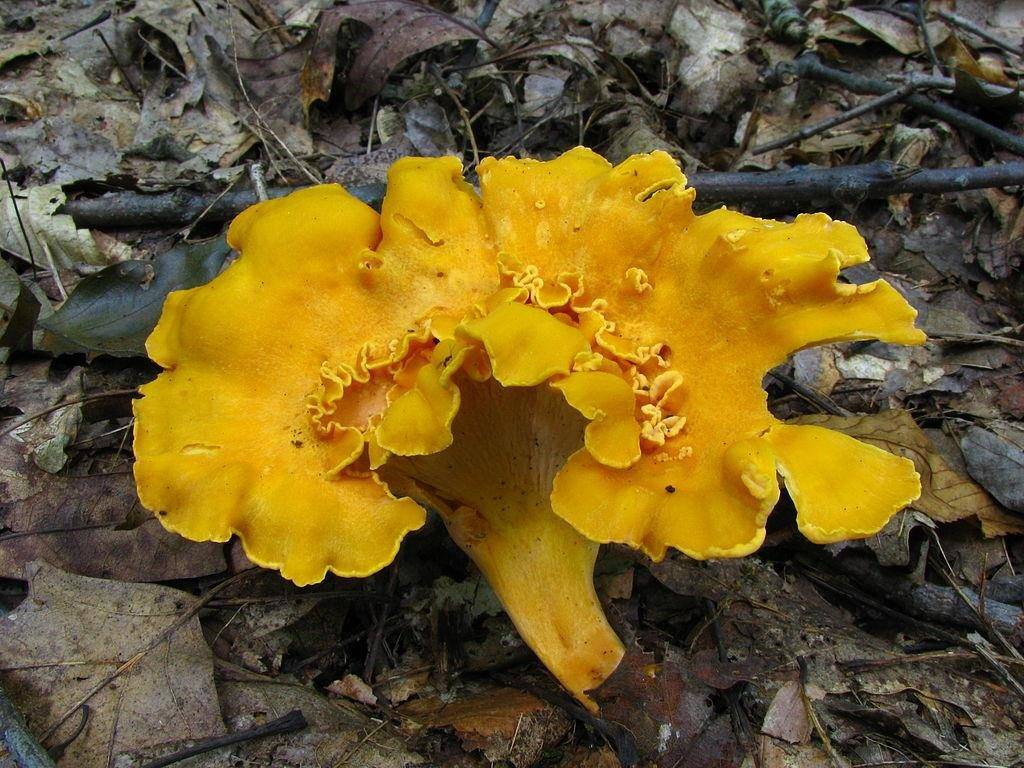
- Chanterelle yellowing (lat... Cantharellus lutescens)- an edible mushroom. The diameter of the cap is from 1 to 6 cm, the length of the leg is 2-5 cm, the thickness of the leg is up to 1.5 cm. The cap and the leg are a single whole, like in other species of chanterelles. The upper part of the cap is yellow-brown in color, with brown scales. The leg is yellow-orange. The pulp of the mushroom is beige or light orange, has no taste or smell. The spore-bearing surface is most often smooth, less often with folds, and has a beige or yellow-brown tint. Spore powder beige-orange. The yellowing chanterelle grows in coniferous forests, on moist soils, bears fruit until the end of summer.
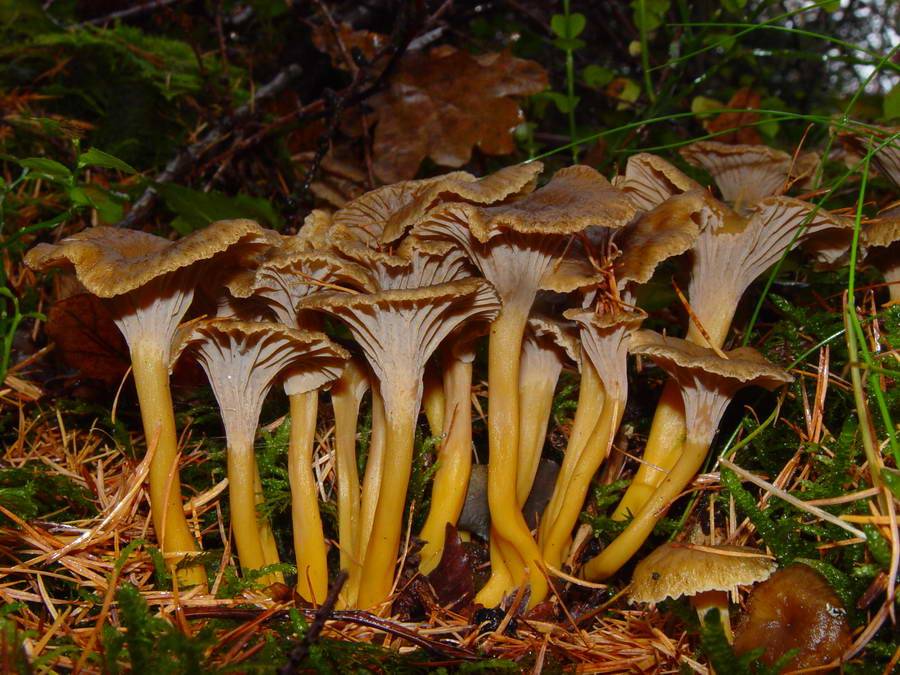
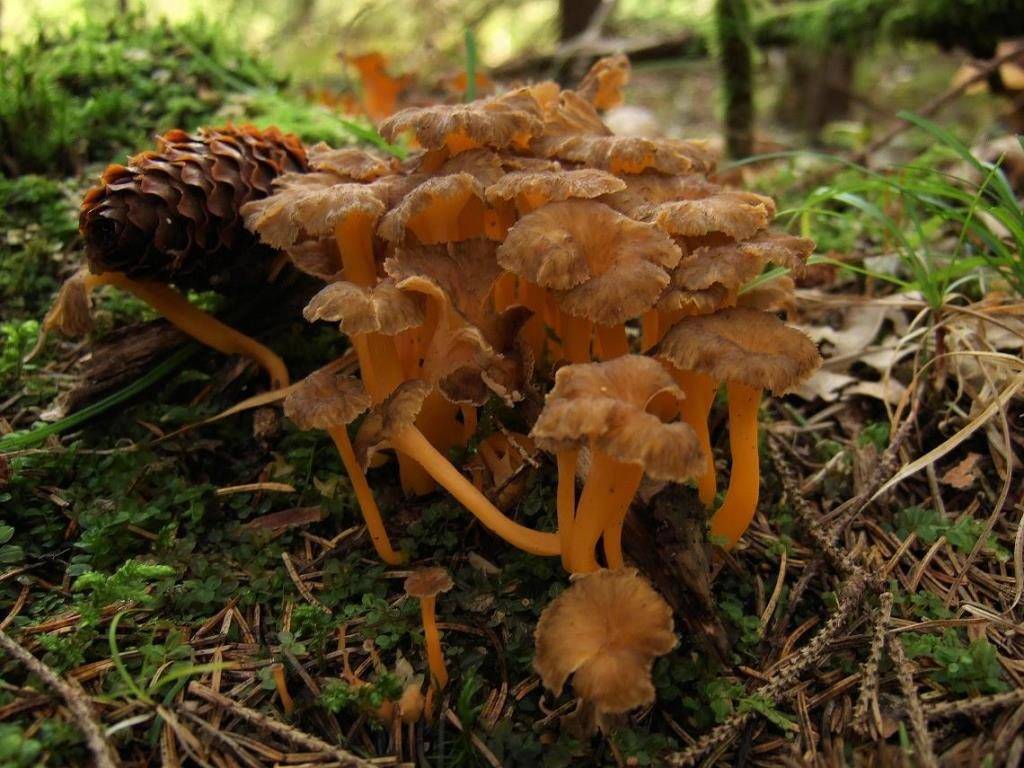
- Tubular chanterelle (funnel chanterelle, tubular cantarell, tubular lobe) (lat.Cantharellus tubaeformis)- an edible mushroom with a cap diameter of 2-6 cm, a leg height of 3-8 cm, a stem diameter of 0.3-0.8 cm. The chanterelle's cap has the shape of a funnel with uneven edges. The color of the cap is grayish yellow. It has dark velvety scales. The tubular stem is yellow or dull yellow. The pulp is dense and white, with a slight bitter taste and a pleasant earthy smell. The hymenophore is yellowish or bluish-gray in color, consists of rare brittle veins. Spore beige powder. Tubular chanterelles grow mainly in coniferous forests, sometimes found in deciduous forests in Europe and North America.
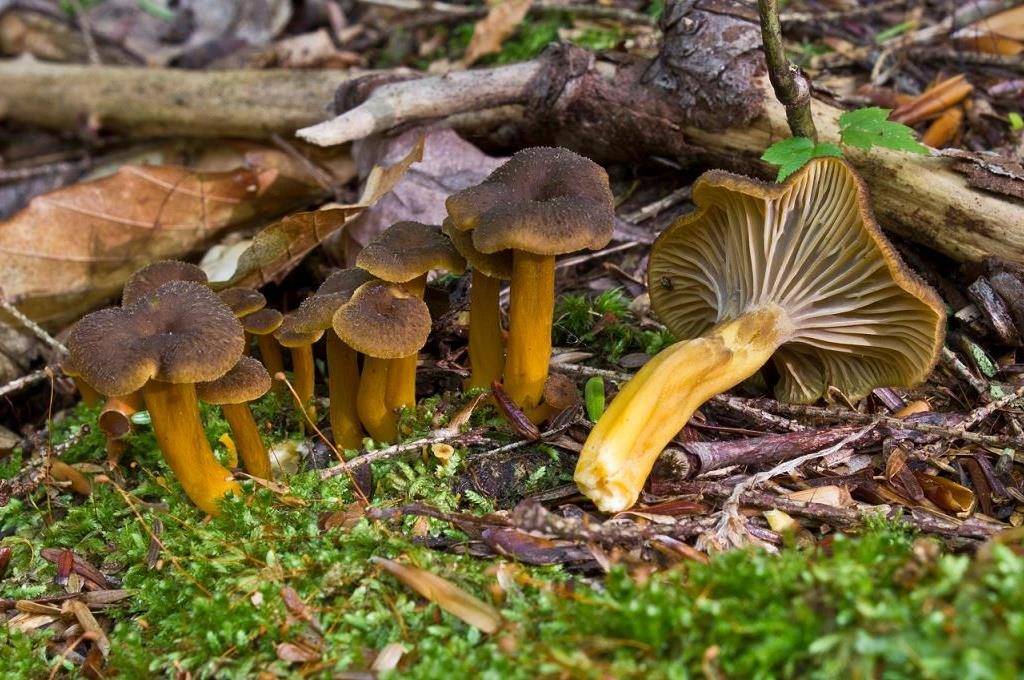
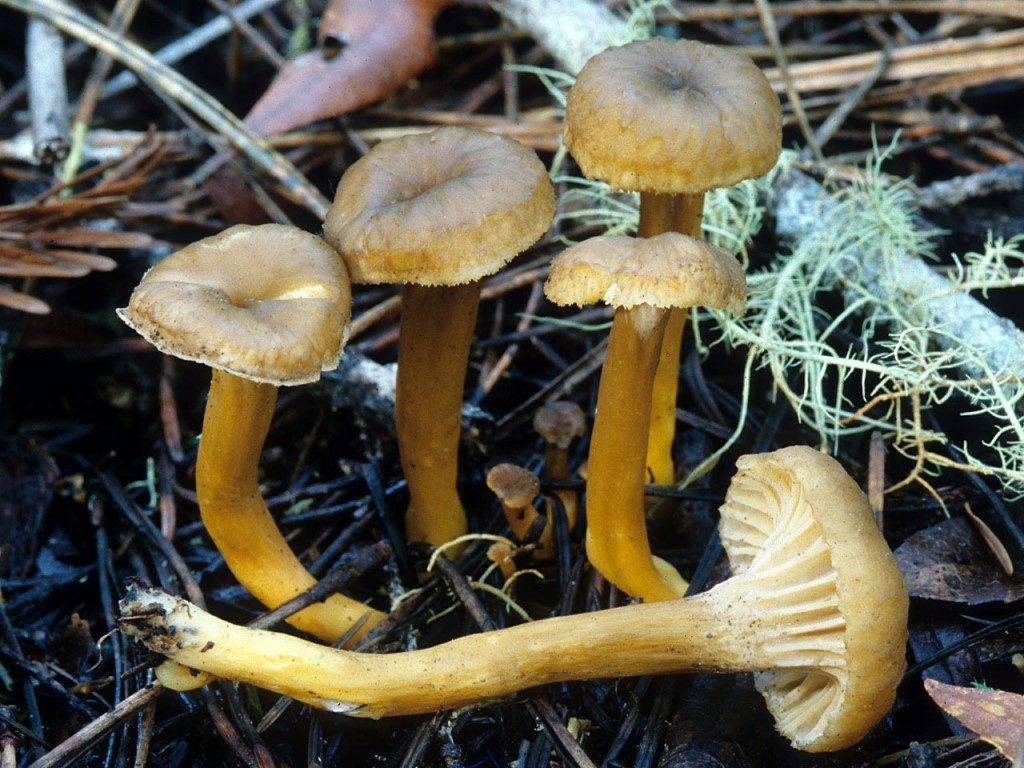
- Chanterelle Cantharellus minor- an edible mushroom, similar to common chanterelle but is smaller. The diameter of the cap is 0.5-3 cm, the length of the leg is 1.5-6 cm, the thickness of the leg is 0.3-1 cm. The cap of a young mushroom is flat or convex; in a mature mushroom, it becomes vase-like. The color of the cap is yellow or orange-yellow. The edge of the cap is wavy. The pulp is yellow, brittle, soft, with a barely perceptible aroma. The hymenophore has the color of the cap. The color of the leg is lighter than that of the cap. The leg is hollow, tapering towards the base. The spore powder is white or yellowish in color. These mushrooms grow in deciduous forests (most often oak) in eastern North America.
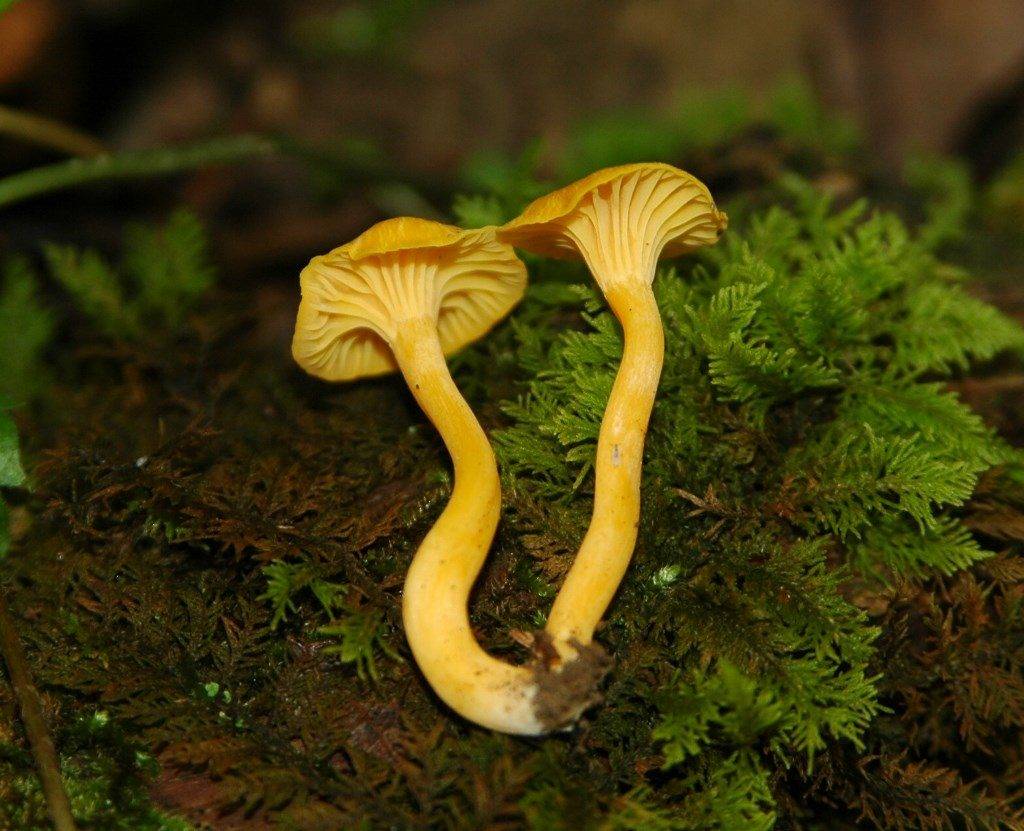
- - edible mushroom of whitish or beige color. Turns orange when touched. The wet mushroom becomes light brown. The diameter of the cap is 5-14 cm, the height of the leg is 2-4 cm, the thickness of the leg is 1-3 cm. The cap of a young mushroom is flat with a wavy edge, with the growth of the fungus it becomes funnel-shaped. Velvet scales are located on the skin of the cap. The pulp of the mushroom has no aroma and taste. The hymenophore has narrow folds. The leg is fleshy, white, uneven or smooth. Spore powder is white. The chanterelle mushroom Cantharellus subalbidus grows in the northwestern part of North America and is found in coniferous forests.
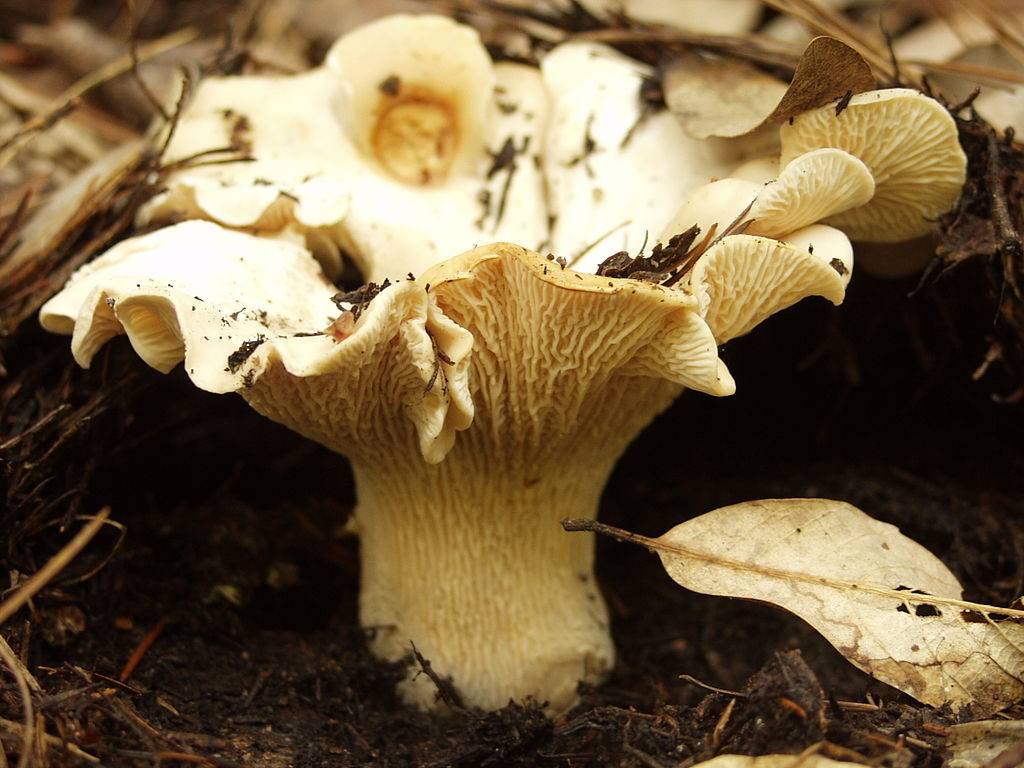
Thanks to its outward appearance, chanterelles cannot be confused with other mushrooms. Their hats and legs look solid and seem to have no boundaries. The hat is irregular, flat and with jagged edges.
It can be concave or funnel-shaped, which is why it resembles the shape of an inverted umbrella. The color is mostly yellowish or with an orange tint.
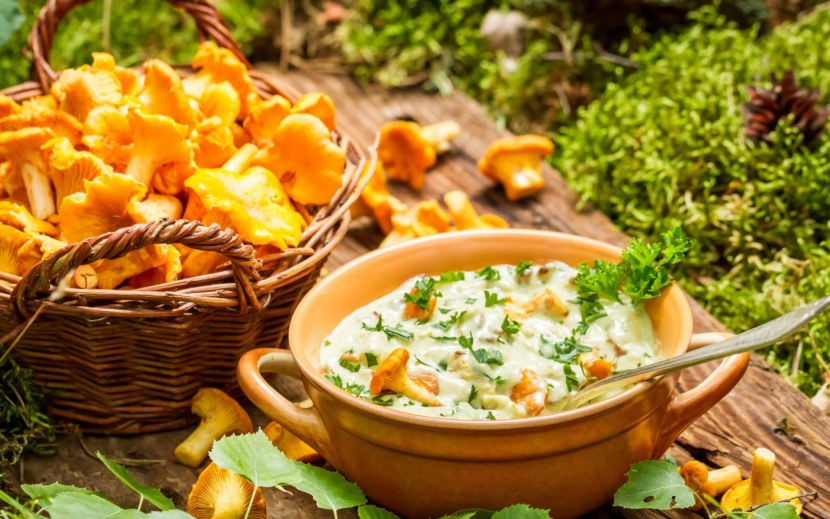
You can find chanterelles in the forest from early summer to mid-October. Mushrooms are often found next to spruce, pine and oak trees. Especially in damp places, in moss, among the leaves on the ground.
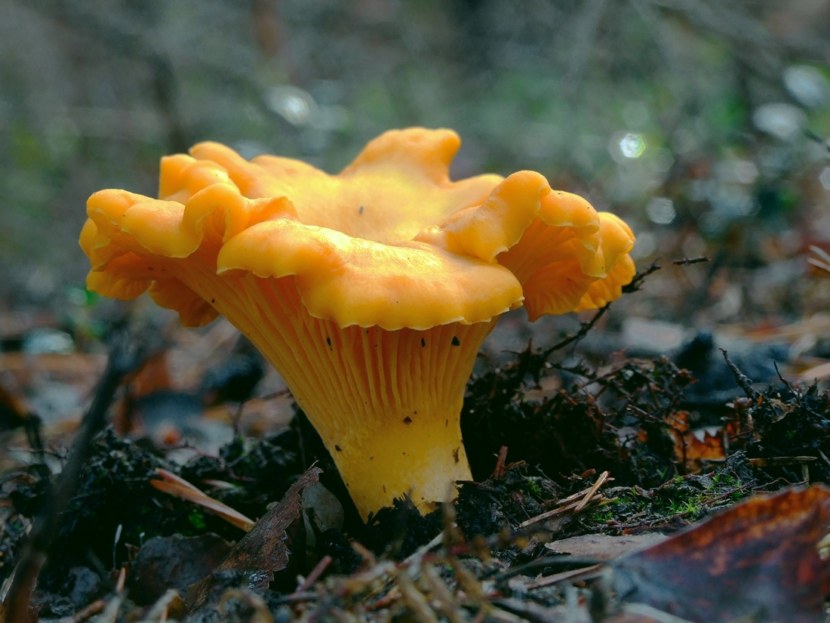
Chanterelles can be easily spotted as they grow in large groups. Below are photos of chanterelle mushrooms, which illustrate what is written above.
What are the types of chanterelles?
In total, more than 60 varieties of chanterelles are distinguished, among them both edible and inedible. The most famous types are listed below:
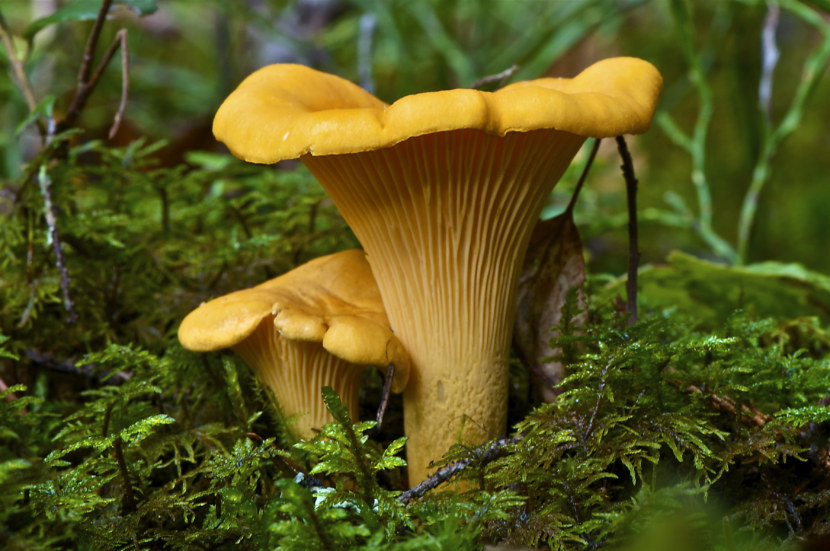
Ordinary. The pulp has a yellowish tint around the edges, the cut is usually white. The chanterelle tastes sour, the leg thickness is 1-3 cm, and the length is 4-7 cm.
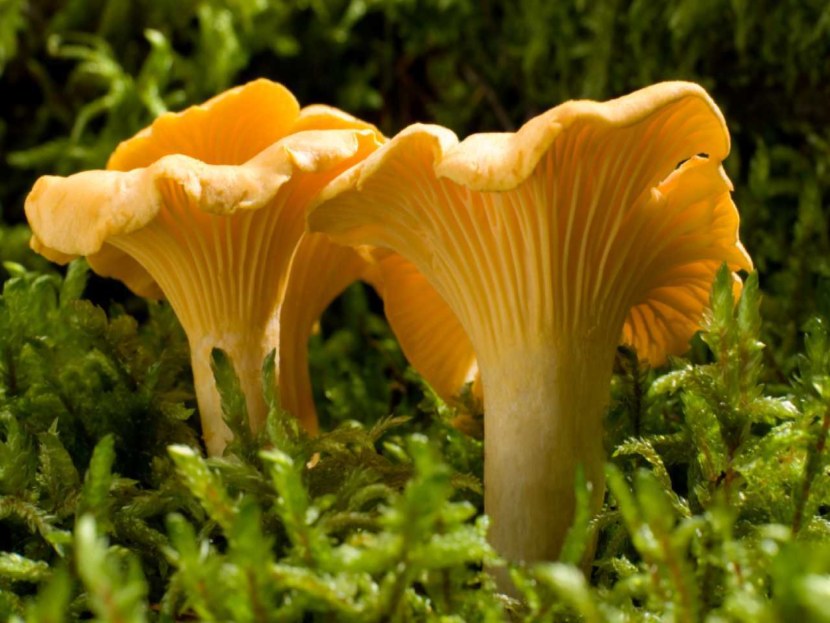
What distinguishes the common chanterelle from other species is the absence of worms or larvae, since the mushrooms contain poisonous components.
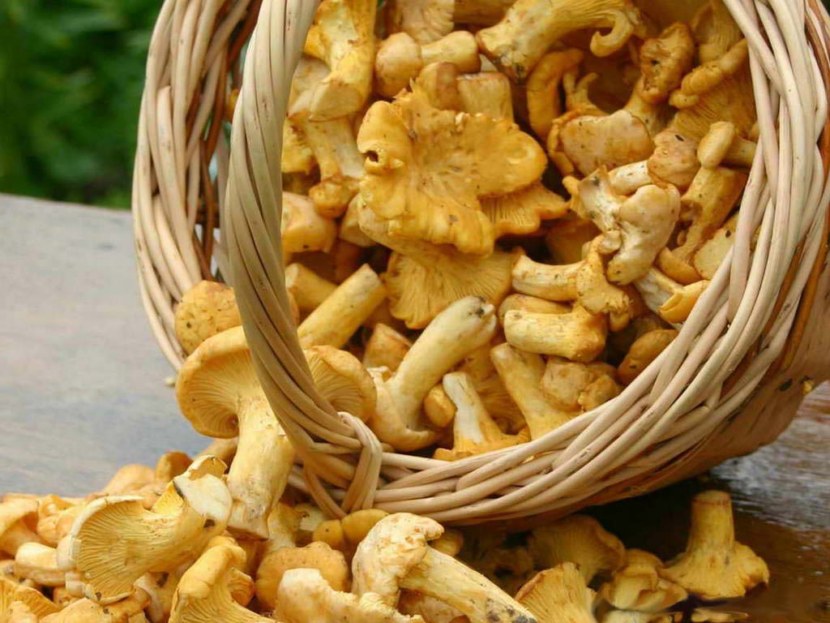
Gray. This variety is little known to mushroom pickers, so they usually avoid them. The hat has waves along the edges and grooves in the center. It is impossible to accurately describe the taste of chanterelle chanterelle, as the variety is not aromatic. You can meet this type of mushroom from mid-summer to mid-autumn.
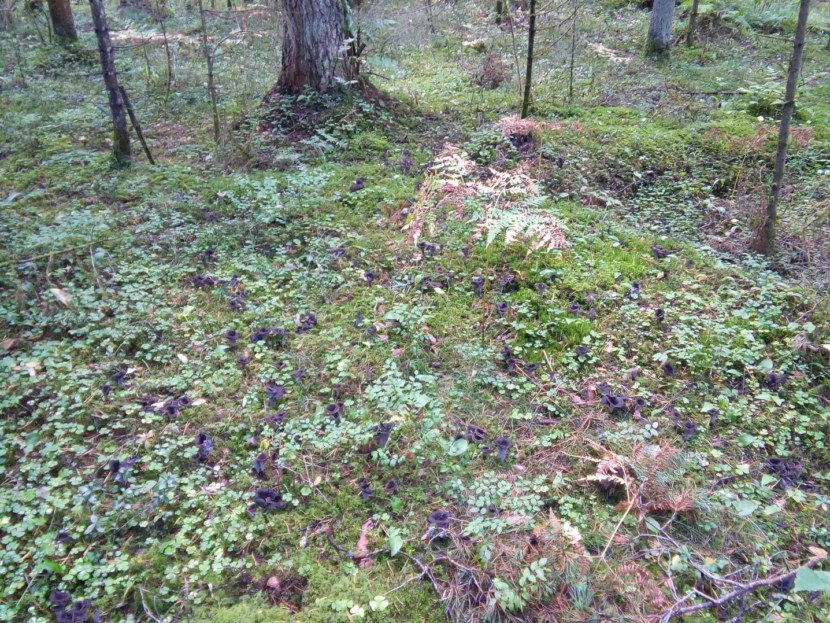
Cinnabar red. This type of mushroom is red and pinkish-red in color. At the edges, the cap is uneven and curved. The fungus can be found in deciduous forests, in oak groves, and in eastern North America.
Velvety. This is one of the rare species of chanterelles. In young mushrooms, the cap is more convex, but the older, the more funnel-shaped it becomes. The mushroom smells good, but tastes quite sour.
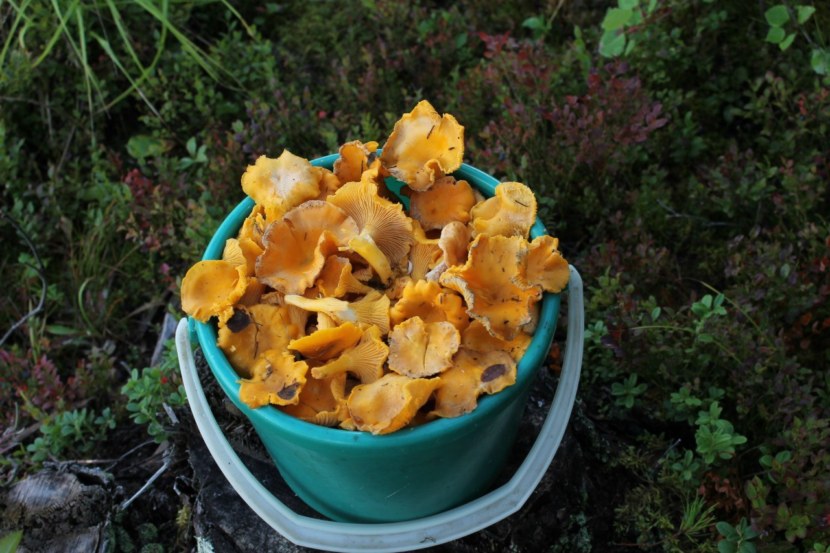
You can meet chanterelles in the south and east of Europe, as well as in a deciduous forest. The collection takes place from July to mid-autumn.
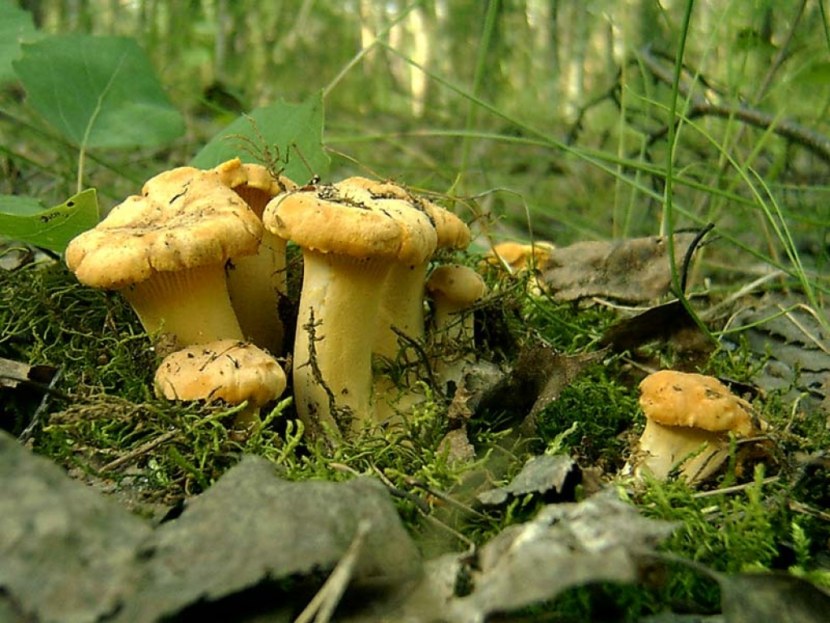
Faceted. The leg and cap of this species of chanterelle mushrooms are connected. The pulp is firm enough and has pleasant smell... To understand where chanterelles grow, you need to go to the oak grove of Africa, the Himalayas. The collection takes place in summer and autumn.
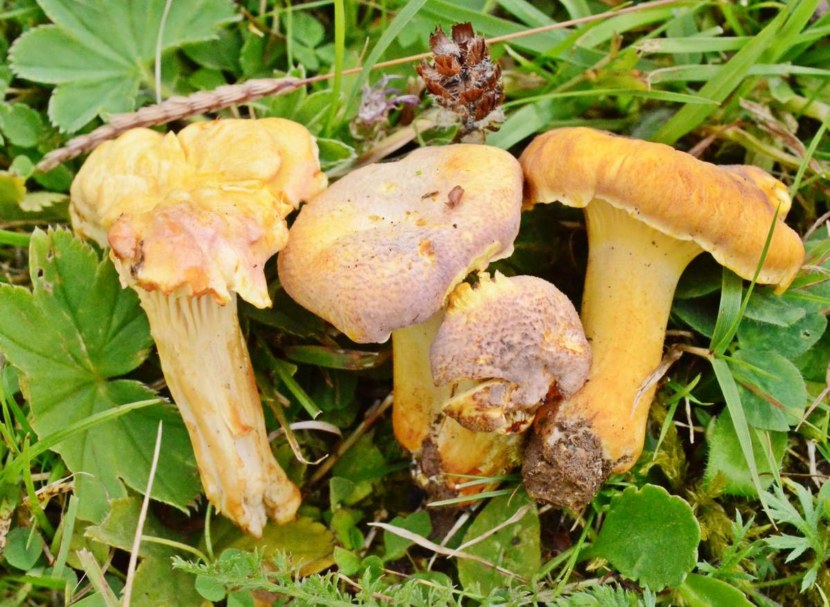
Yellowing. Its top is yellowish and the bottom is orange. The pulp has beige color but odorless and odorless. Often, yellowing chanterelles grow in a coniferous forest, on moist soil, and they can be harvested until the end of the summer season.
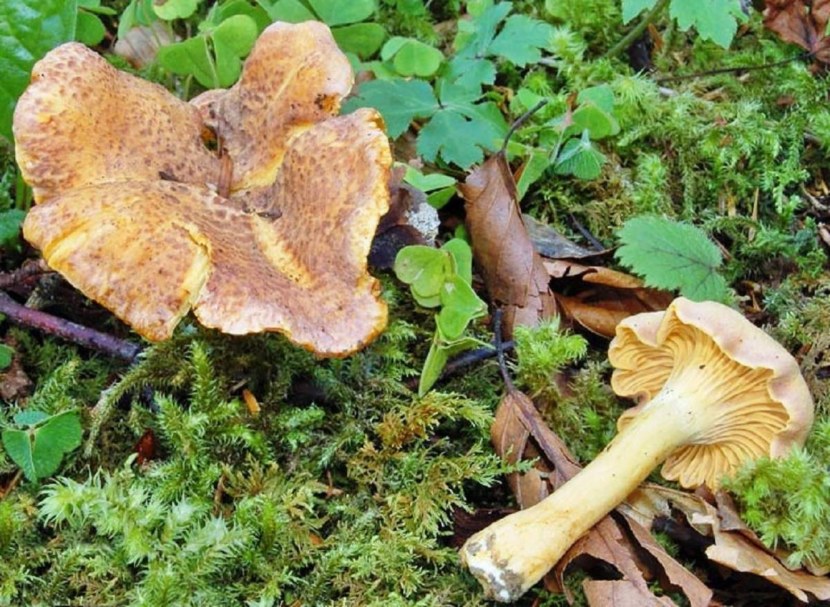
Tubular. The cap of this type of mushroom has a funnel shape, scales are found on it. The flesh is usually white, has a bitter taste and smells like soil. Deciduous and coniferous forests are favorite locations for these mushrooms.
Cantharellus minor. This type of mushroom can be easily confused with other varieties, but it is distinguished by its small size. The color is predominantly yellowish and orange. The leg of the chanterelle is hollow; towards the end it becomes narrow. Travel to the deciduous forest to collect Cantharellus minor.
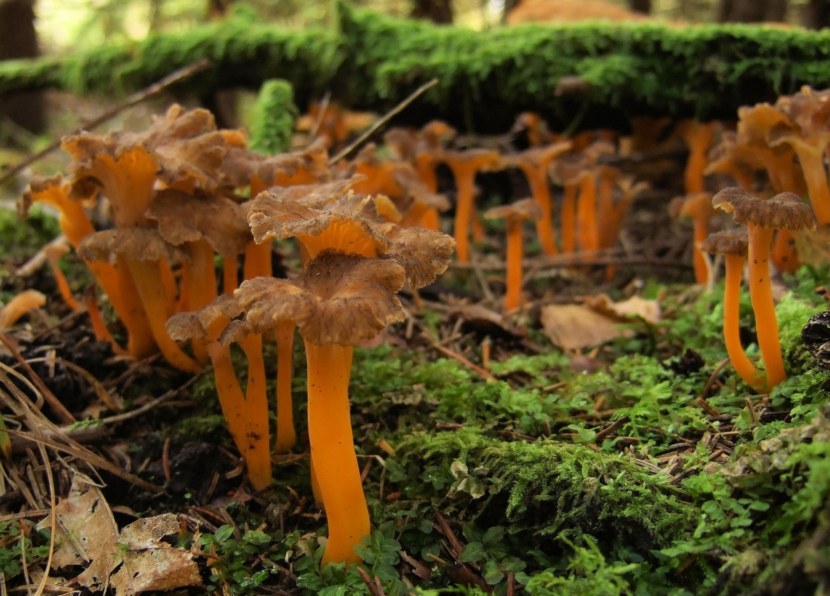
Cantharellus subalbidus. The color is mostly white or beige. The cap looks wavy at the edges, the leg is fleshy and uneven. Coniferous forest is the most common location for this variety.
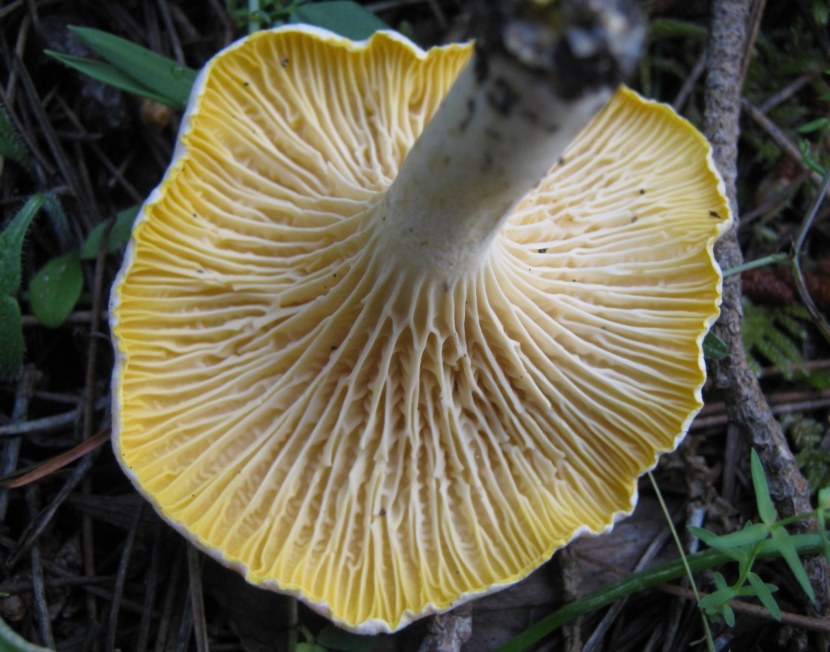
Edible and inedible chanterelles: what's the difference?
Below is a description of chanterelle mushrooms, among which there are both edible and inedible species.
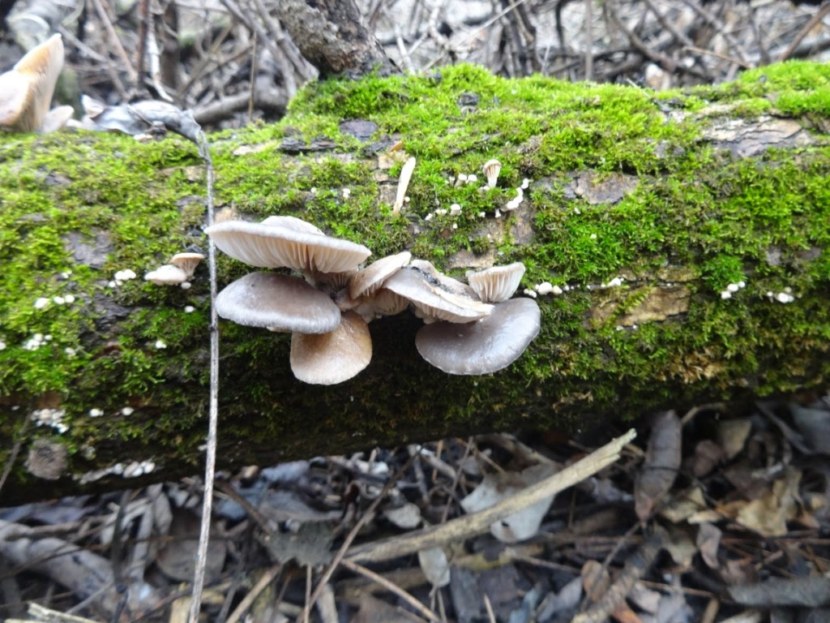
- A normal mushroom will have a light color, a dangerous one will have a bright color;
- The first type has torn edges, and the false one has perfectly smooth edges;
- A thick leg is found in edibles, a thin leg in inedibles;
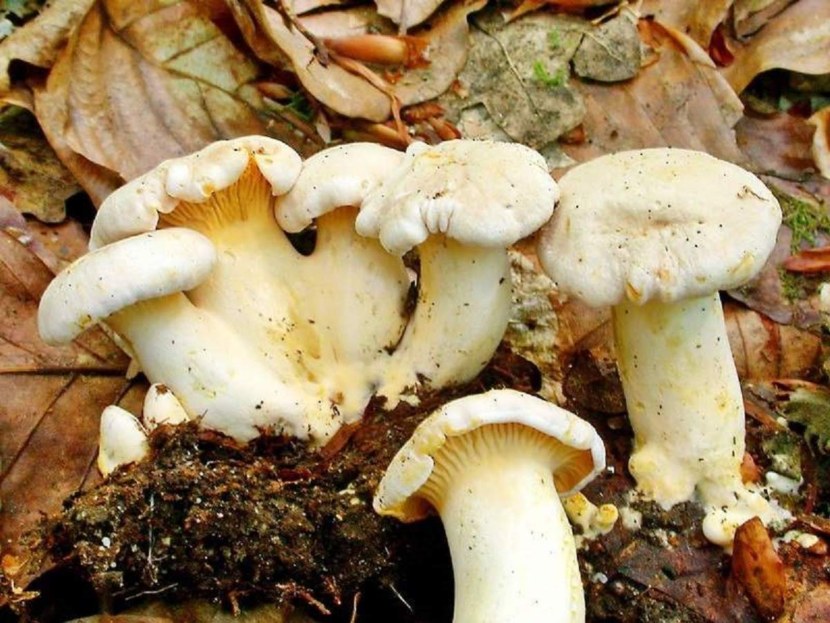
- The first type of mushrooms grows in groups, and the second one by one;
- Healthy mushrooms smell good;
- From pressing on the pulp correct chanterelle reflected red;
- There are no worms.
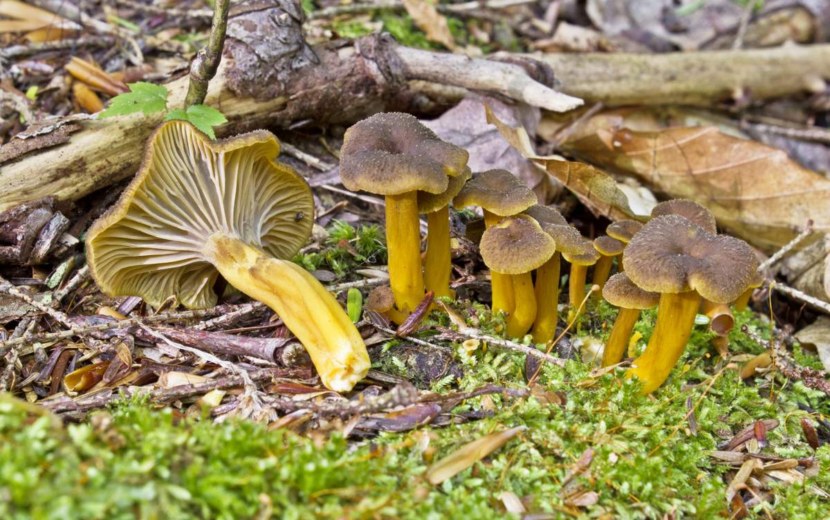
Why are chanterelles useful?
- They contain many vitamins;
- There are almost no worms;
- The ergosterol content in ginger mushrooms helps to strengthen the organs;
- Useful for curing diseases.
There are three ways to store chanterelles: salt, dry and freeze. The latter method retains useful substances in them.
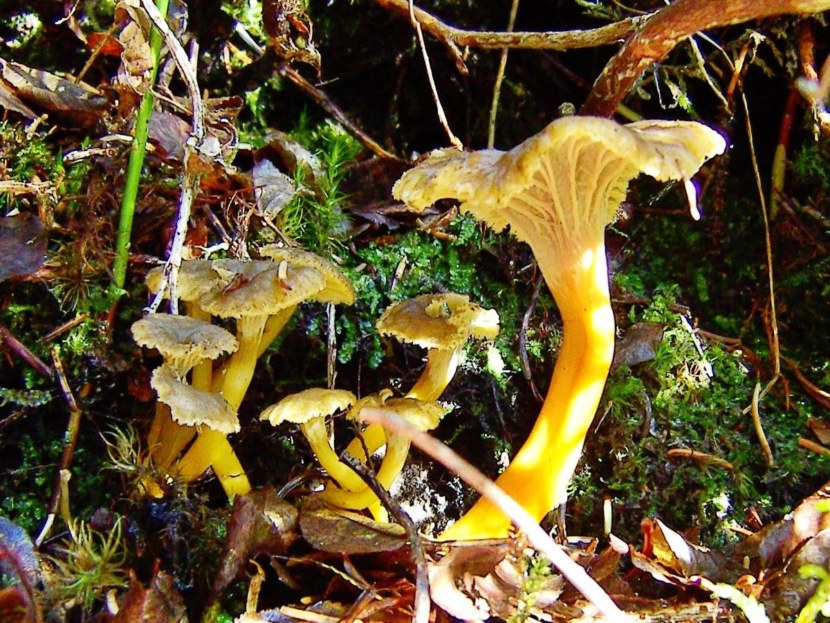
For basic requirements, avoid storage in the room.
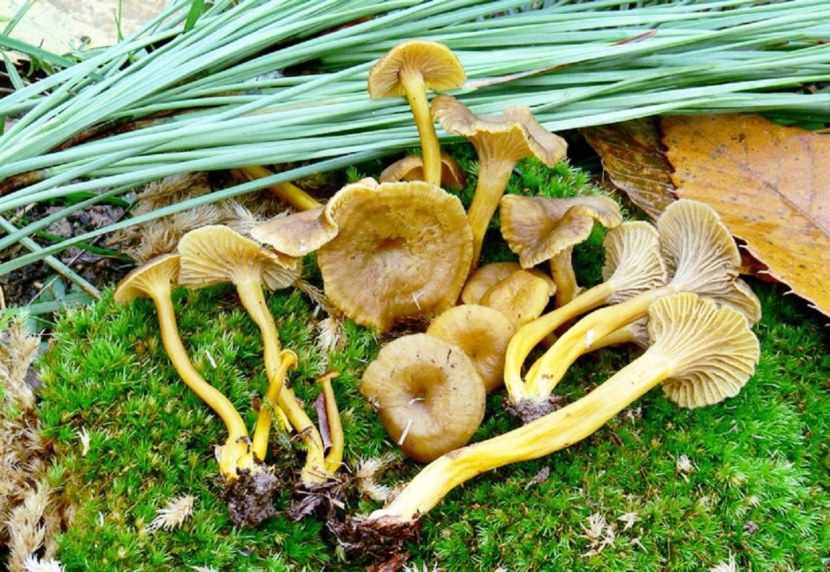
The ideal temperature for all varieties should not exceed 10 degrees, and you need to store no more than a day. Better process them as soon as possible.
Processing mushrooms means cleaning them from debris and separating them into healthy and damaged ones. Then rinse the chanterelles and pat dry on a towel.
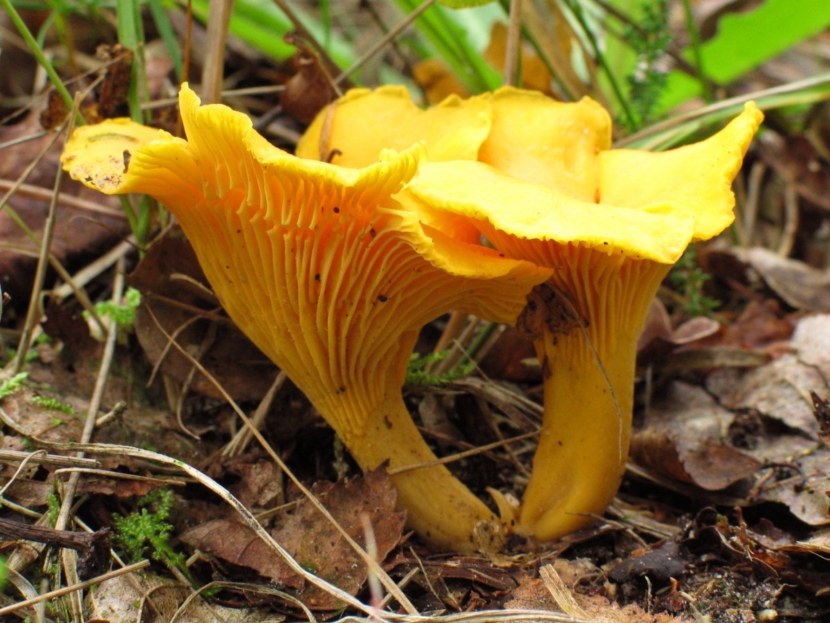
Make sure that little moisture remains on the mushrooms. Boil the mushrooms in a saucepan before frying in a pan.
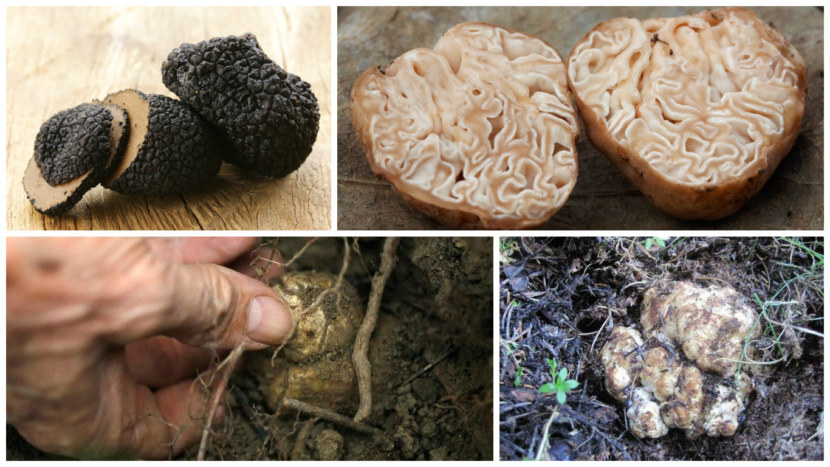
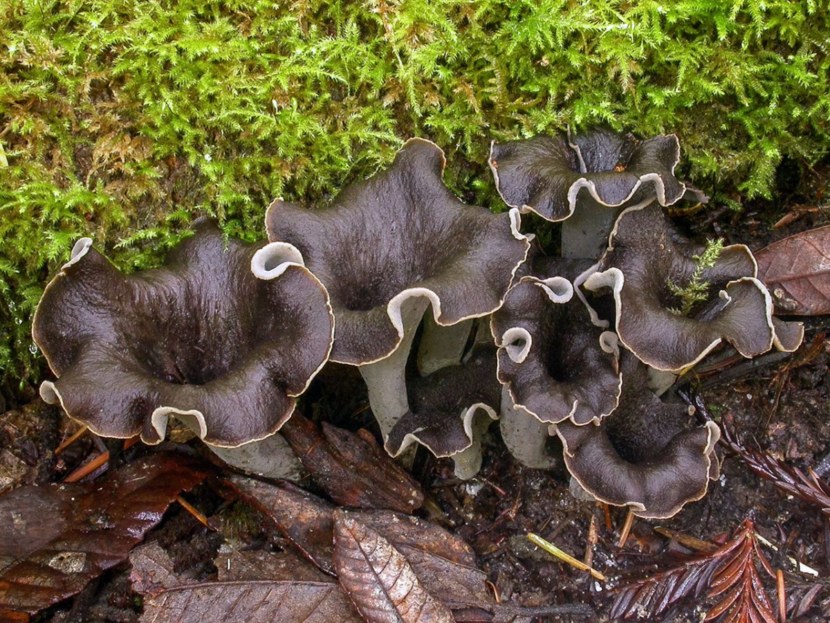
Photo of chanterelles
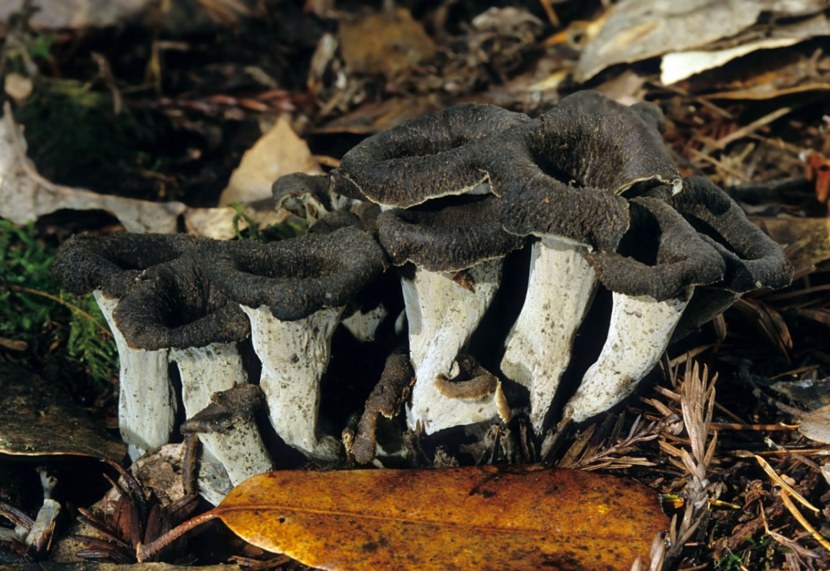
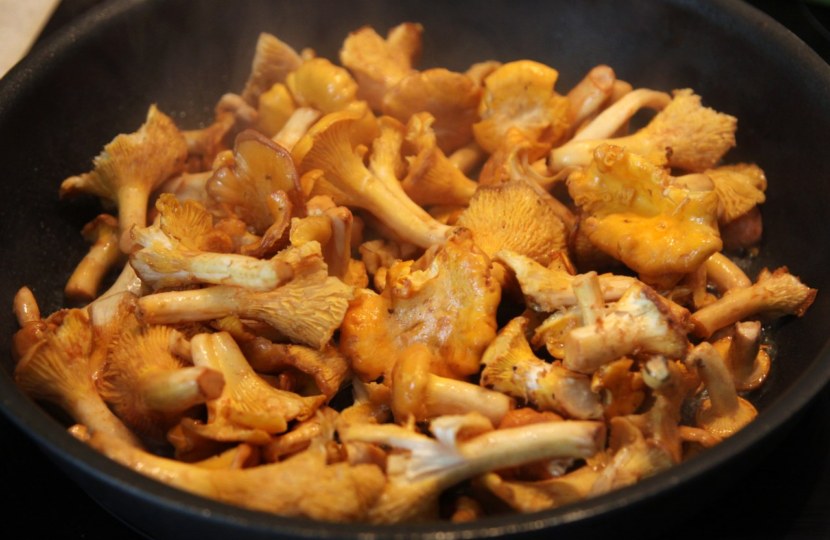
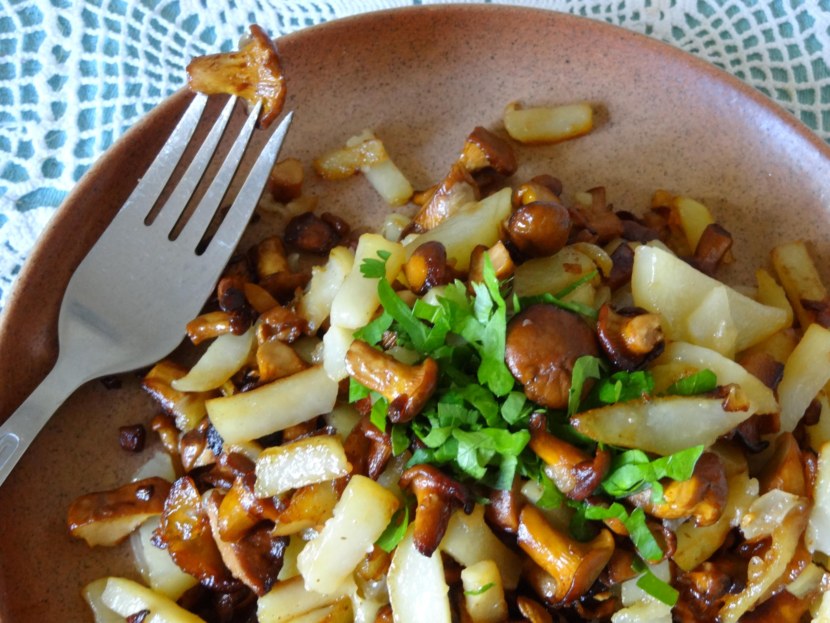
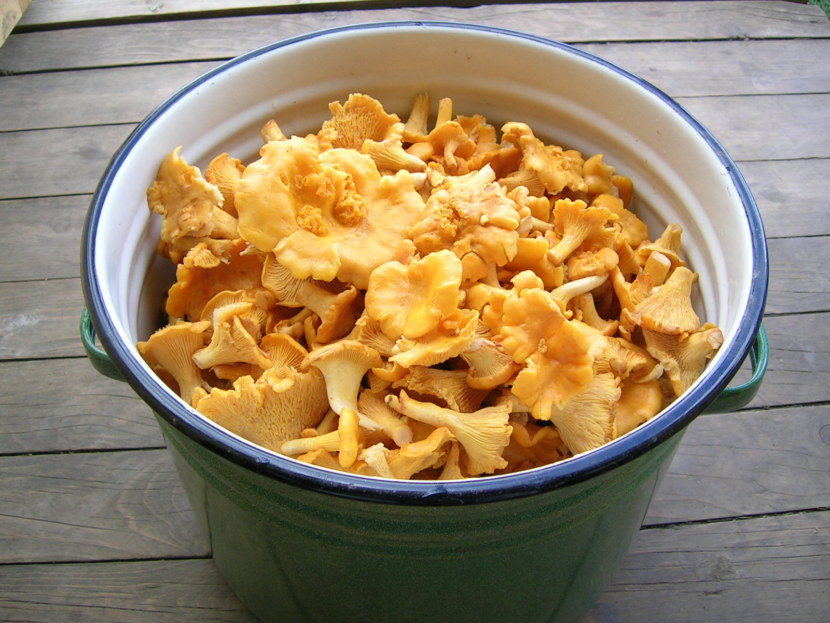
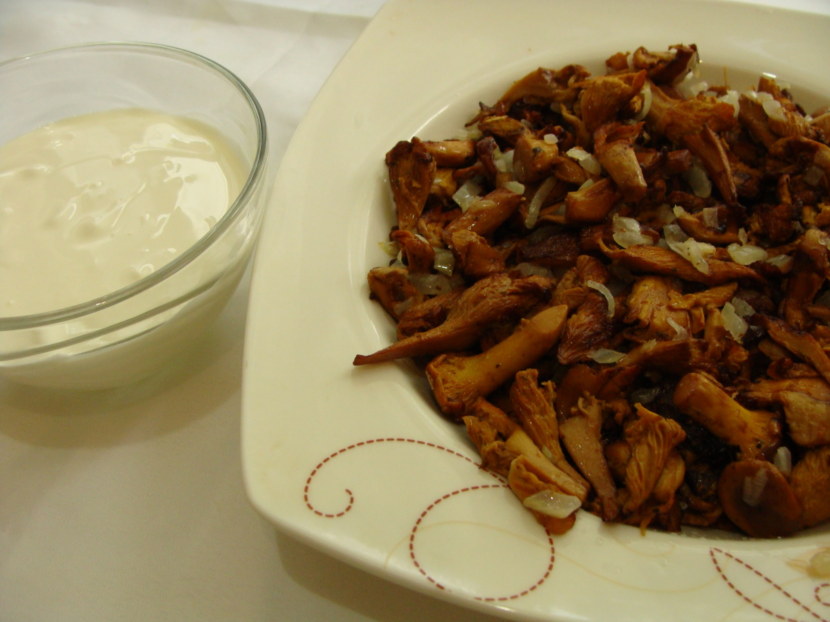
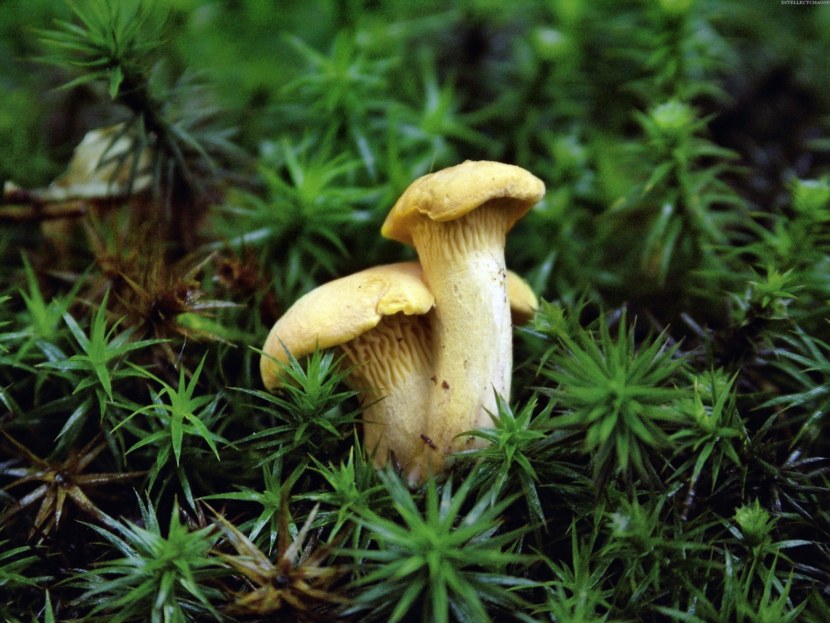
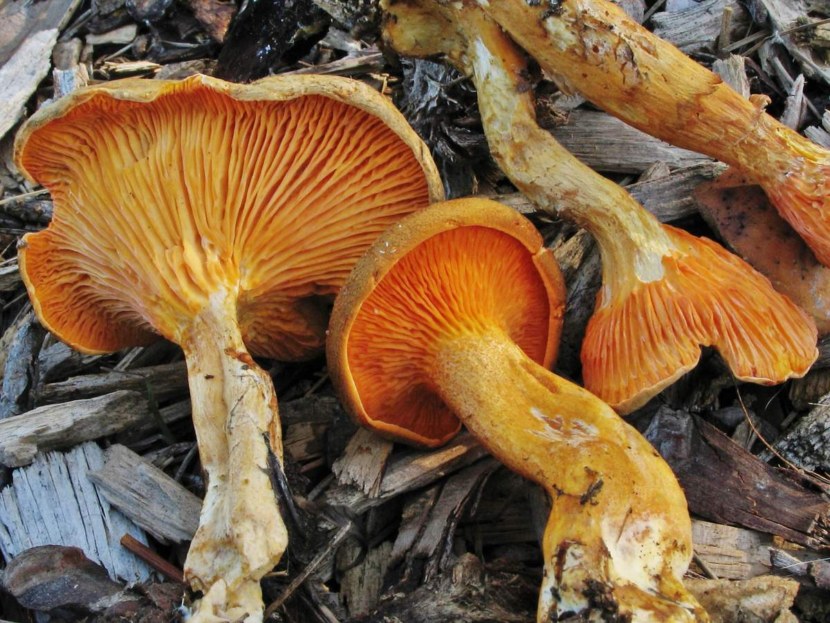
![]()
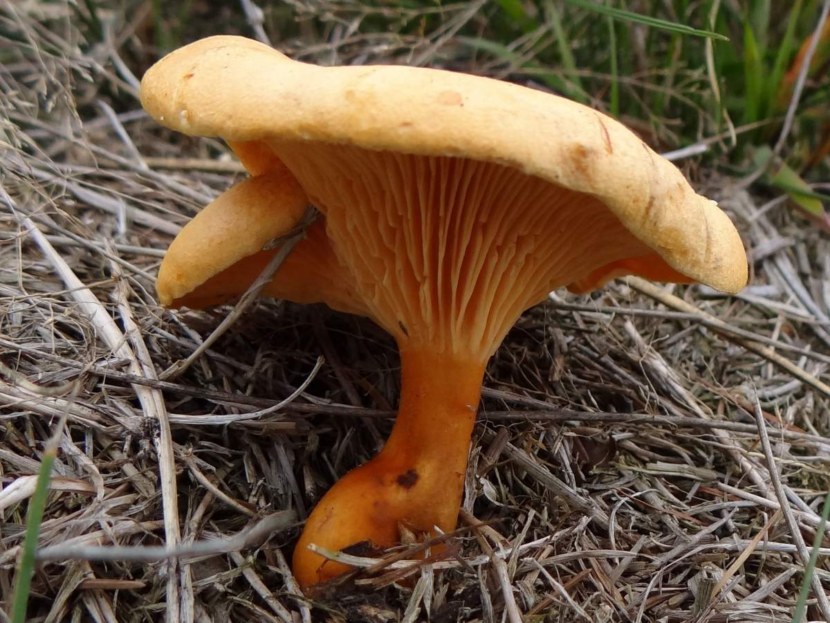
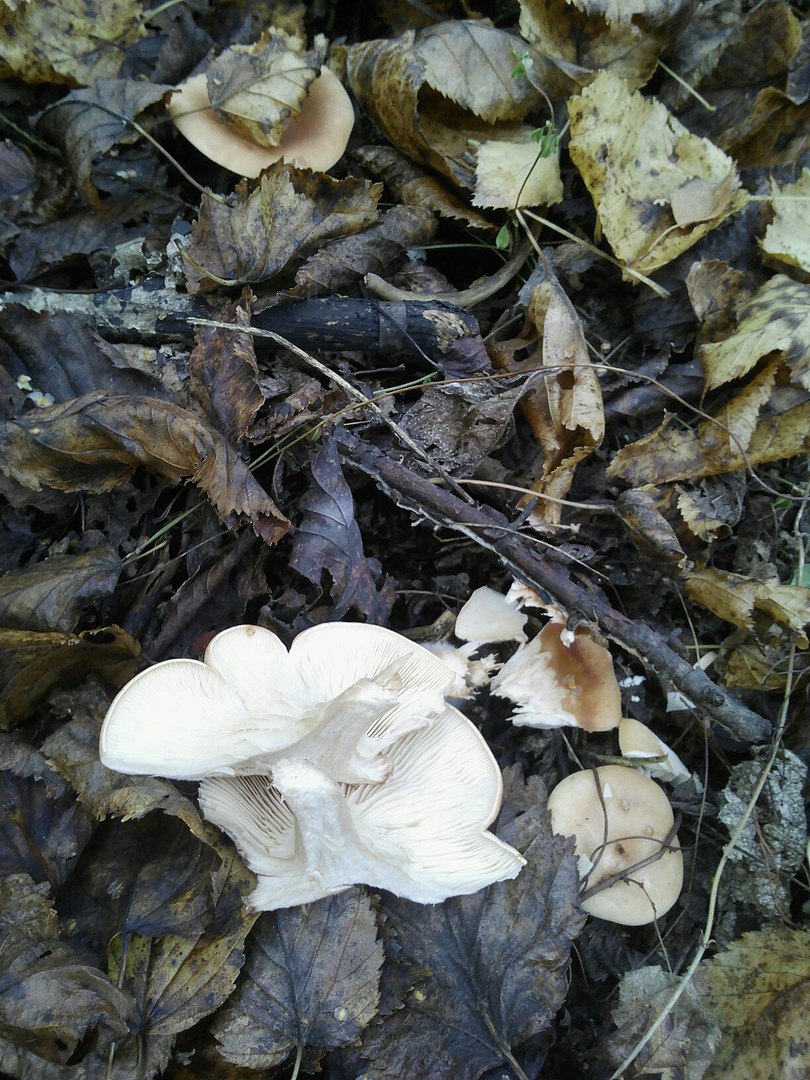
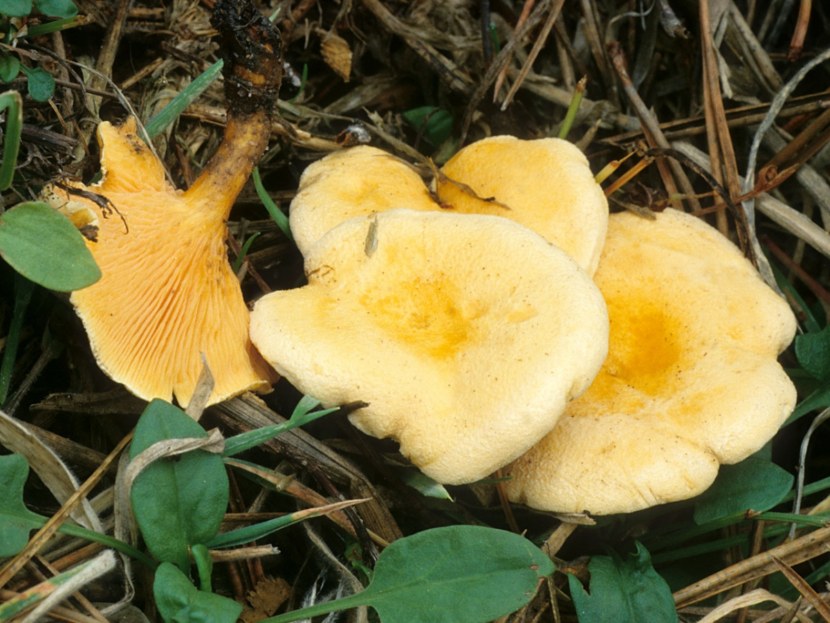
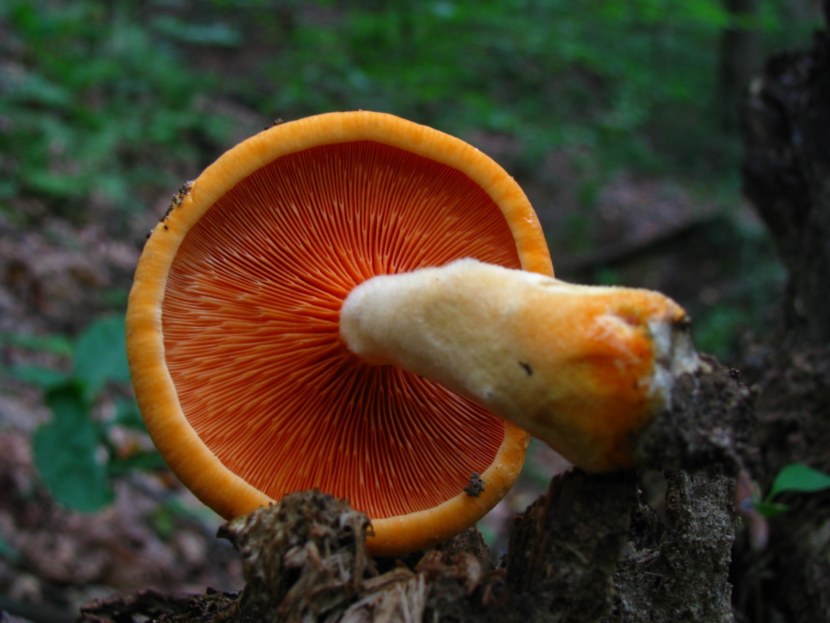
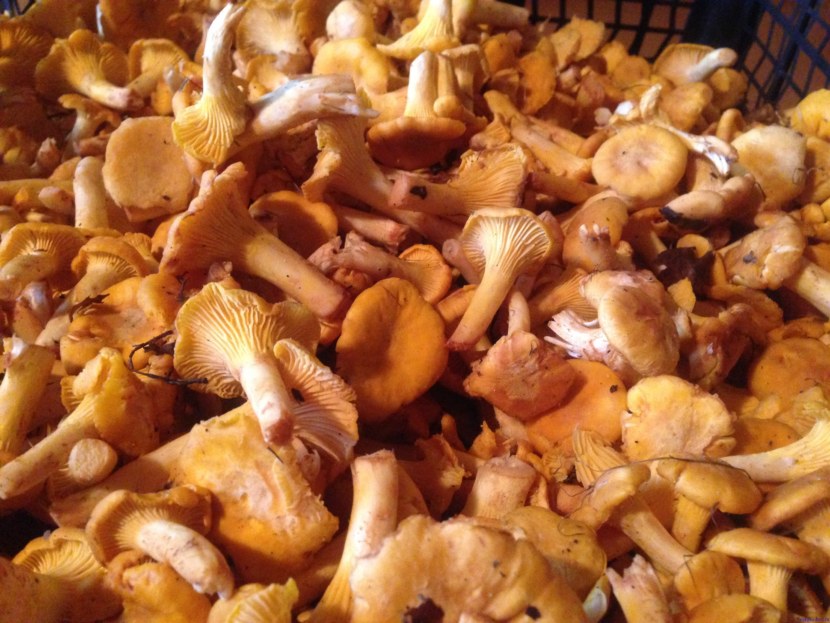
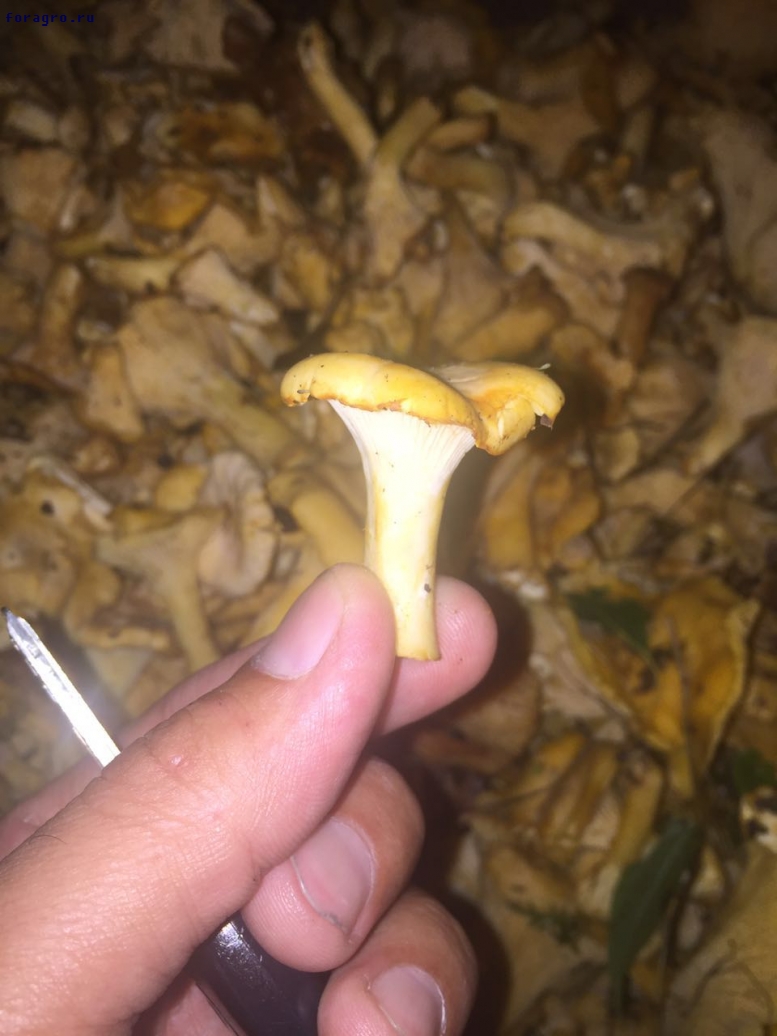
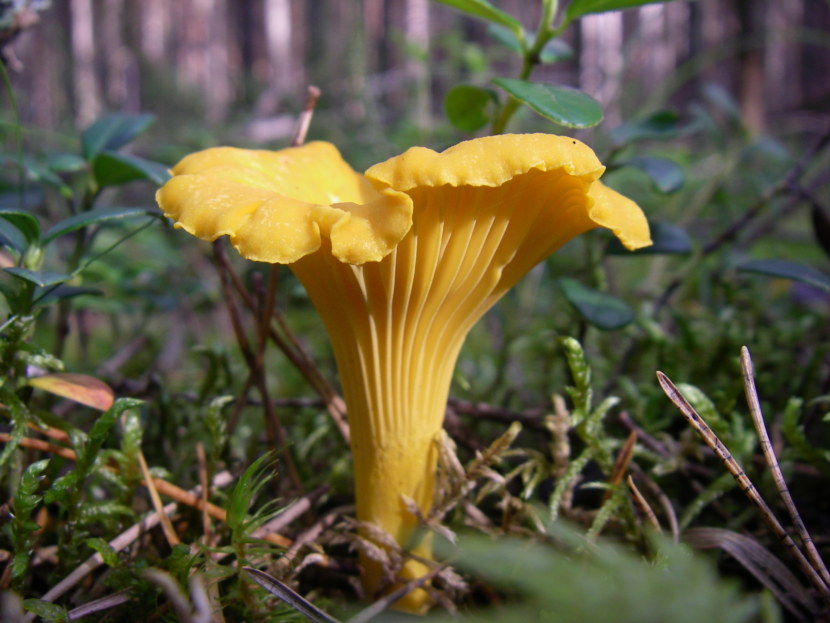
Orange talker (Hygrophoropsis aurantiaca) belongs to the family Hygrophoropsidaceae, genus Gigroforopsis. Its other name is more common - a false chanterelle, obtained due to the similarity with the edible mushroom of the same name. In some regions it is better known as kokoshka.
False chanterelles look like this:
- The cap is small, from 1.5 to 6 cm in diameter, in young mushrooms it is flat, with a lowered edge and a depressed center; later takes on a distinct funnel-shaped shape. The surface is dry, velvety. The color of the cap is bright, orange with a red, yellow or ocher tint. With age, it becomes buffy-beige or whitish-reddish.
- The leg is up to 5 cm in height and thin - no more than 1 cm, even. The cap can bend under the weight. Colored in the color of the cap, dark at the base, almost black. The pulp is cotton-like, fibrous
- The plates are frequent, branched, and noticeably descend to the pedicle; painted in the color of the cap.
- The pulp is light, sometimes with a yellowish tinge, more often whitish. The smell is weak, mushroom.
You cannot eat false chanterelles - until recently, this rule was known to every mushroom picker. They are classified as inedible or even poisonous mushrooms. Recently, information has appeared about their transfer to the section of conditionally edible with two caveats: especially careful Preliminary processing and people with a weak digestive system are still better off not eating them. But there is no reliable information confirming the edibility of kokoshes. But there are more than enough reports of numerous poisoning by false chanterelles with serious consequences. Therefore, it is better to follow the proven rule: do not take dubious mushrooms. This will allow mushroom pickers to maintain their health and the opportunity to continue to enjoy their favorite pastime.
Distribution and fruiting season
The false chanterelle is a mushroom widespread in the Northern Hemisphere. Prefers coniferous or mixed small-leaved forests. Selects mossy places with an abundance of litter, dead wood, rotting wood. It finds coolness and moisture under leaves, fallen trees and rotting stumps.
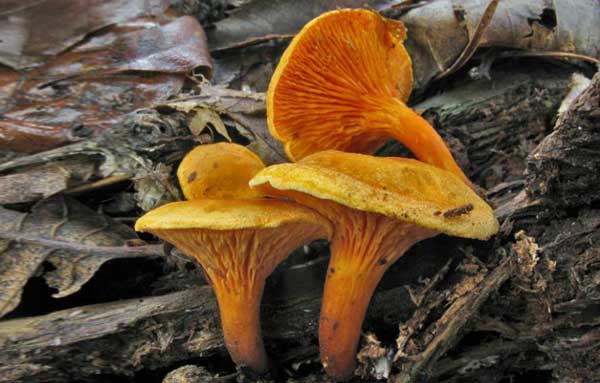
Kokoschki can grow in groups or singly. Even with group germination, the fruit bodies are at some distance from each other. The peak of fruiting occurs, depending on the weather, at the end of summer or beginning of autumn.
Similar species and how to distinguish from them
The only "twin" of orange talkers are edible chanterelles. These mushrooms are very similar: only experienced mushroom pickers can distinguish false chanterelles at a glance.
False and real chanterelles differ, first of all, in color. In a kokoshka, it is bright and rich, with a clear orange, orange-red tint. Have edible mushroom it is more moderate: yellow-orange or light yellow, white-yellow, without red and red tones.
The surface of the cap in the edible mushroom is smooth, in the false one it is velvety. You can identify a false chanterelle and around the edges of the cap: neatly rounded, even, smooth. In a real mushroom, they are wavy, torn, irregular in shape; the hat itself is large. The plates of the false double descend on the leg, and for the present, they pass into it.
Gives out an orange talker and a leg: thinner than that of a real one, and dark at the base. Chanterelle legs are thicker, do not bend, taper downward, and are uniformly colored along the entire length. False chanterelles can be distinguished by their pulp: it is yellowish, loose, and does not change color when pressed. The flesh of a real chanterelle is white in the middle and yellowish at the edges, and turns red when pressed. Has a pleasant mushroom smell and rarely becomes wormy.
True chanterelles always grow in groups, avoiding places clogged with rotting wood. But you can find both types and side by side. Therefore, it is important to know what false chanterelles look like. Once in the basket along with edibles, they can lead to food poisoning.
Food quality, possible harm
Information on the toxicity of false chanterelles is conflicting. In some foreign sources, they are considered edible, but they are not recommended for consumption. First, due to extremely low nutritional qualities, secondly, because of the high probability of poisoning. To reduce it, the mushroom is advised to soak for several days in water, like milk mushrooms, then boil for 30 minutes, and only then cook. Naturally, the loose, cotton-like pulp of the talker after such processing turns into a tasteless mess.
Russian mycologists are more conservative. They argue that you can get poisoned by false chanterelles, regardless of what preliminary preparation Was held. These mushrooms are really mildly toxic, and toxins can be destroyed when exposed to high temperatures. But it is impossible to determine at home whether the poison is completely neutralized. Therefore, it is safer to treat false chanterelles as inedible.
Poisoning: symptoms, first aid
The false chanterelle contains toxins that affect the functioning of the stomach, intestines, liver, and kidneys. Even pre-processed mushrooms can cause poisoning, and those that have not gone through the soaking and boiling procedure are guaranteed to cause it.
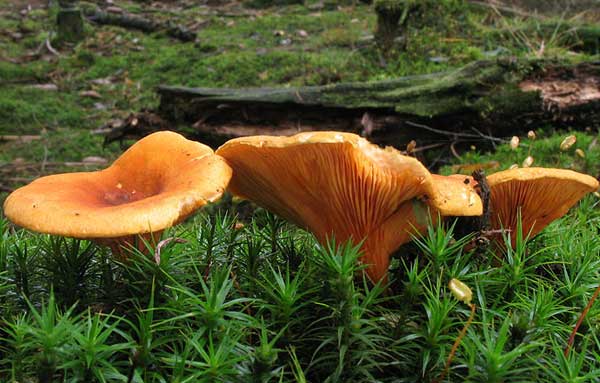
Symptoms of poisoning appear approximately 30 minutes after the entry of toxins into the body; depending on the general condition and age, this time can increase up to 3 hours. If a small amount of toxins are ingested, they can show their harmful effects in a day.
Among the symptoms of poisoning with false chanterelles, the most common are:
- weakness;
- loose stools;
- stomach pain, vomiting.
The main danger of these fungi is that pathogenic bacteria, including those that cause botulism, often settle on them. As you know, high temperature does not destroy them, but, on the contrary, stimulates reproduction. If, in addition to fungal toxins, bacteria have entered the body, then signs of poisoning will appear much later (up to 3 days) and will be accompanied by high fever, visual impairment, and dry mouth.
If signs of poisoning appear, you should immediately seek qualified medical help. Many people believe that you can "cope" with them on your own: they wash the stomach, take sorbents and drink plenty of fluids. In the case of cocoons, this is not enough, since there is a threat of the development of concomitant diseases, for example, botulism.
The false chanterelle has always been classified as an inedible, weakly poisonous mushroom. It is for this reason that novice mushroom pickers often bypass real chanterelles - in order to distinguish them, a certain skill is needed. Despite the fact that the mushroom is advised to be treated as conditionally edible, the attitude of lovers of quiet hunting has not changed. Indeed, risking health for the very dubious pleasure of tasting a tasteless, fibrous, cotton-wool mass is, to say the least, stupid.

